Guide
Financial Leverage
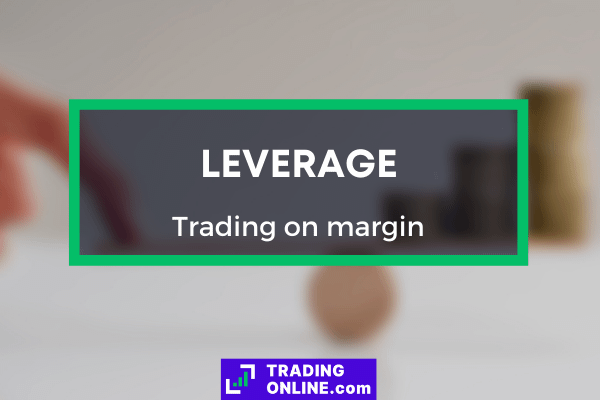
Leverage is a tool offered in Forex and CFD investments, which allows to multiply the performance of the asset in which we have invested.
Created as a tool for Forex trading, nowadays it is available on all CFDs, ETFs and other types of derivative instruments, Futures and options. Financial Leverage can be a useful tool to increase the volatility and price movement of financial security or to be able to expose ourselves to positions much larger than the capital we can commit.
Although many consider it to be a shortcut to greater gains in online trading, leverage is a double-edged sword that must be handled with extreme care by the investor.
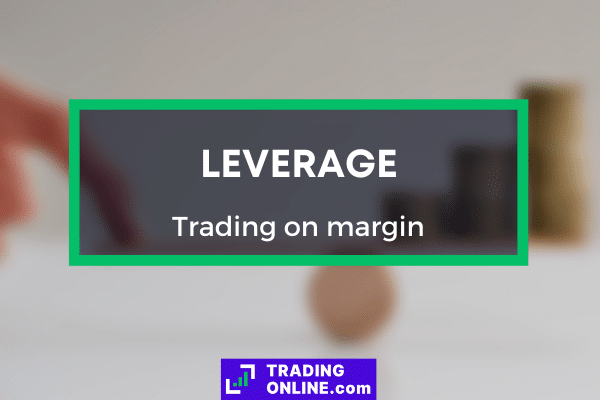
As far as the European continent is concerned, the maximum leverage that can be applied to each asset class is set by ESMA, which has intervened repeatedly in recent years to limit the margin provided by this tool, at least for non-professional clients.
Financial leverage – Main features:
| ❓Why it is used: | Multiplying fluctuations, heding, trading on margin |
| 🤔Assets: | Forex, stocks, ETFs, derivative contracts, commodities, cryptos, indeces |
| 💰Costs: | Overnight fees depending on the interest rate |
| ⛔Risk | High |
| 👍Where can you use it: | Best online trading platforms that allow trading on margin |
What is financial leverage: definition
Financial leverage is technically a loan from the broker, which allows us to make larger investments than we could make using only our capital. Our capital will be used as collateral. If the loss of the total capital we have invested exceeds our collateral, the position will be closed automatically. If we make a profit, it will be calculated on the total amount we have invested (guarantee and borrowed capital).
Let’s see how this mechanism works:
- Technically it is a loan
Whenever we open a leveraged position, we are in effect getting a loan from our broker, who usually relies on external liquidity providers to ensure that all his clients never run out of money to borrow.
If we buy with 1:5 leverage 1,000 euros of Apple shares, we will be exposed for 5,000 euros in the market, automatically borrowed by the broker (and its liquidity providers). The 1,000 euros we have committed will be used to hedge against changes in the price of the stock.
If we buy with 1:5 leverage 1,000 euros of Apple shares, we will be exposed for 5,000 euros in the market, automatically borrowed from the broker (and its liquidity providers). The 1,000 euros we have committed will be used to hedge against changes in the price of the stock.
- Multiply profits and losses
Depending on the leverage we are going to use, this tool will multiply the performance of the stock we have chosen. Let’s take the example of an investment in stocks, on which we have chosen to apply a leverage of 1:2.
Our capital will have to cover 50% of the total investment and if the stock rises by 5%, we will obtain a total gain of 10%, that is 5% x 2. However, the trend is multiplied even in case of loss. If the security we have chosen and on which we have invested with 1:2 leverage were to lose 5%, we would find ourselves with a net -10% in capital, for the same principle as above.
- Legal restrictions apply
There are different laws around the world regarding leverage. Within the European Union, for example, the relevant financial authority is ESMA. ESMA has limited by law the leverage that brokers can offer to non-professional clients, so for example on stocks you usually get a leverage of 1:5.
In the U.S., the Commodity Futures Commission has imposed a maximum leverage of 1:50. This level of leverage can only be offered on the most liquid Forex pairs, while for the rest of the Forex pairs it drops to 1:20 and the value drops further for instruments such as stocks and ETFs.
In the UK the maximum leverage is limited by the Financial Conduct Authority to 1:30; in Australia ASIC has recently limited leverage to 1:20 and each nation has its own rules on this. However, there are jurisdictions that offer very generous rules, especially in Pacific atolls and exotic nations, where leverage easily reaches as high as 1:200 or 1:500.
- Hedging tool
Leverage is often used for hedging positions, that is, making investments that hedge the risk of others. It is in this case a tool for complex strategies and, at least among professional investors, it is the most frequent reason why leverage is used.
Financial leverage: how exactly does it work?
Leverage has practical applications that today can only interest small and medium investors: it is no longer a tool reserved for complicated inter-bank operations but a possibility offered by a large number of brokers and intermediaries even in retail investment accounts.
- How leverage works in Forex
The currency market lends itself because on the one hand it is relatively stable, and on the other hand because it is a necessary market for many to hedge against the foreign exchange risk of other types of investments denominated in foreign currencies.
In most jurisdictions, Forex enjoys higher limits on leverage because it is believed that this market is less risky than others. Applying leverage to any Forex order will result in a net multiplication of the performance of our investment.
Therefore, leverage in Forex can be used for those who are looking for higher returns while exposing themselves to higher risks. Alternatively,financial leverage in the currency market can be used for hedging purposes, for example, to cover the risk of buying a package of shares in an exotic currency.
- Financial leverage in CFDs
CFDs are derivative instruments that allow you to invest in different types of underlying assets, from commodities to stocks, passing also through ETFs, bonds, stock market indices and cryptocurrencies. This type of contracts can integrate a financial leverage that can be chosen by the investor at the time of opening the trade when placing the order.
The principle of operation is the same as we have seen in Forex. In fact, we can choose any leverage point – within the maximum set by law – and multiply the performance of the underlying asset we have chosen. Contrary to what happens with ETFs, with CFDs we can choose how much leverage to apply to a single investment.
The reasons for hedging can also be valid in this case, choosing for example a notoriously anti-cyclical asset like gold. Being able to have leverage helps to expose yourself for larger positions than you can actually support with your capital.
- Leverage in ETFs
ETFs, increasingly popular instruments, often already incorporate financial leverage. In this case, the result is obtained thanks to complicated synthetic replication schemes, with the result of being able to offer those who want products that already have a prefixed leverage.
Therefore, it is not uncommon to find securities on the market that already incorporate financial leverage at 2, 3, 5 or 7 on assets that replicate the performance of oil, or natural gas or other commodities.
- The cost of leverage
Financial leverage is technically a loan and therefore has its own interest costs, which should be carefully considered before setting an order. In fact, for both Forex and CFDs there are so-called overnight commissions, i.e. daily commissions in the form of interest that are charged at the end of each trading day.
We have to remember that these commissions, which are always due when trading with this kind of instruments, are calculated having as “taxable base” the whole position, i.e. the whole exposure after the application of leverage.
If we invest on EUR/USD with a leverage of 1:30 1.000 euro, we would be exposed for 30.000 euros in total. The overnight fee should be calculated directly on the 30,000 euro exposure. The differences in cost compared to an investment without leverage should be considered. The best day trading brokers offer a preview of this cost already in the order phase, allowing us to better assess the impact of commissions.
- The risks of leverage
Financial Leverage, as a multiplier of the positions we have in the market, amplifies the risk. Each loss will correspond to a loss multiplied by the level of leverage that we have chosen.
To a greater potential gain always corresponds a greater exposure and therefore a greater risk of losing money. For this reason, we must, before exposing ourselves to this instrument, evaluate the risk we are willing to run in the hunt for a certain level of profit.
Leveraged Investment Examples
We will now do two different examples of leveraged investing, one on Amazon shares and one on gold, using two of the different brokers.
Leveraged investing in Amazon shares with eToro
- First step: get a demo account with eToro
To test our first order we will need a free eToro demo account, an account that provides 100,000 USD of virtual capital that we can freely use for this purpose. After signing up, we can move on to the next point.
- Second step: login to the eToro platform
The second step is just as simple. Using the credentials we chose during the registration phase, we will be able to make our entry into the proprietary trading platform that is offered by eToro.
- Step three: we locate Amazon shares
Amazon shares are listed at NASDAQ and we will be able to find them on eToro via two channels. We can use the search that is positioned at the top of the interface, or follow the path Markets>Stock>NASDAQ>AMZN. In any case, once we have located the relevant stocks on the screen, we can click on TRADE NOW to place our leveraged order.
- Step four: enter the Amazon stock order with leverage
From the screen you see further down you can enter the volume of money or number of Amazon shares to buy, any stop losses and take profits and then set the leverage. eToro allows you to choose between x1 leverage (no leverage), x2 leverage and x5 leverage on stocks in general. We choose the one that best matches our investment strategies and move to an Open position to start the order, which will be immediate.
Note that this broker reports the cost of overnight commissions resulting from the use of leverage, i.e. interest on borrowed money. However, the costs are very small: on a 4,540 USD position in x5 leverage, we are paying 4 USD per day, less than 0.001% of the invested capital.
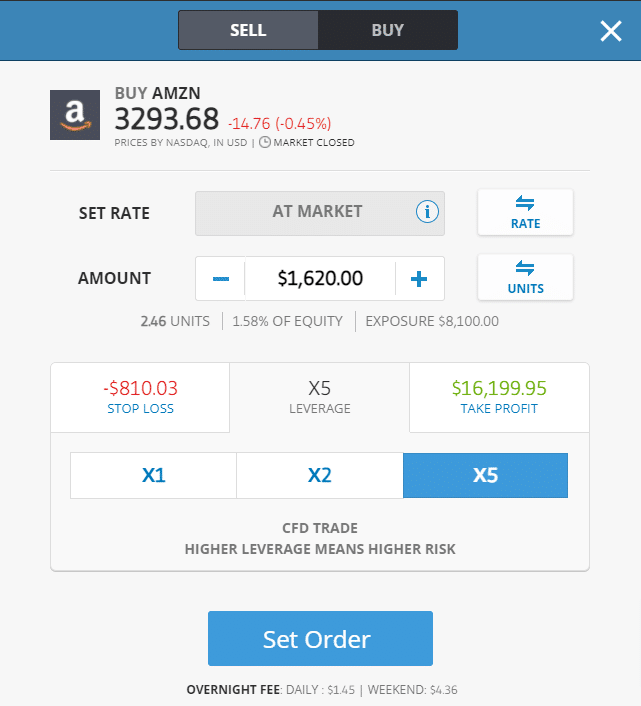
Buy GOLD on Capital.com with leverage
Capital.com has another way of approaching the issue of leverage and does so by automatically inserting the maximum possible leverage on each order, with the maximum that can be contained by going to modify the platform settings.
- First step: sign up for a demo account with Capital.com
Here we can open the demo account with Capital.com, which allows us to get 1,000 USD test capital to invest in any type of market that is offered by this broker. Once we enter our email and chosen password, we will be diverted directly inside the investment platform of this broker.
- Second step: finding gold on the platform
We can find gold on the platform offered by Capital.com by going to the menu on the left, choosing “Commodities“. Just click on it and then choose GOLD. Let’s click BUY to proceed.
- Third step: place the order
After we have chosen gold, on the right column we can insert our order measured in ounces. Under the quantity we will also find the indication of the margin, i.e. the amount of money we are going to commit to go and buy the certain amount of gold we have indicated.
The functioning of this broker is very particular in this sense because it is not possible to modify the maximum leverage applied during the order phase. To do so, we will have to go to Settings > Trading Options and then change the leverage applied from the screen that we have shown below. The change can also be done on an order by order basis. Once we deem the appropriate leverage and other details of our order correct, we can move on to the order by clicking BUY.
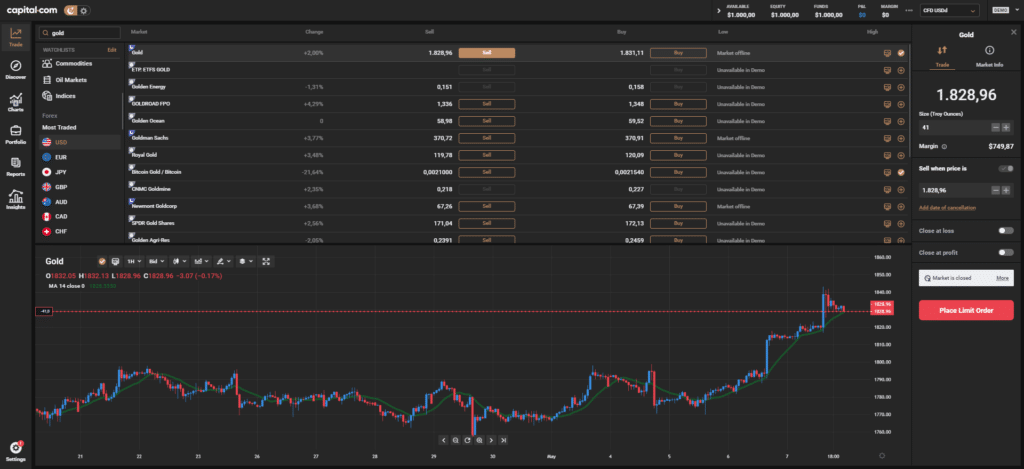
Best trading platforms with financial levarage [TOP LIST 2021]
[broker]
All the best European Forex and CFD brokers offer leverage within, in trading platforms jurisdictions where it is allowed by law. Let’s also see what their main features are outside of leverage.
It is one of the most popular brokers in the world and allows you to go and invest in over 2,100 securities, spread across stocks, Forex, commodities, cryptocurrencies, ETFs and indices. It offers a CFD mode for all leveraged investments, while also offering a DMA (Direct Market Access) mode on Stocks, ETFs and Cryptocurrencies when you choose to trade without leverage.
In relation to what is offered by this broker in terms of leverage, we should definitely highlight also the possibility to invest by spending very small amounts in terms of overnight commissions. The commissions and operations of eToro can also be checked with its free practice account, which allows you to invest freely under the same conditions as real accounts.
In relation to what is offered by this broker in terms of leverage, we should definitely highlight also the possibility to invest by spending very small amounts in terms of overnight commissions. The commissions and operations of eToro can also be checked with its free practice account, which allows you to invest freely under the same conditions as real accounts.
Capital.com is a Forex and CFD broker that applies maximum leverage limits on all the products it has listed. In Capital.com’s free demo account it is also possible to trade with higher levers, which are those guaranteed to those who log in as professional investors.
10,000 USD (renewable) of virtual capital, proprietary platform and access to over 3,000 securities complete the picture of a valid broker that has many satisfied clients in Europe, as evidenced by the reviews of both our staff and the most reliable third-party sites.
FP Markets is a multi-asset broker that operates with different levels of leverage in the various countries in which it operates. The service is particularly focused on offering Forex pairs, American, Australian and Hong Kong stocks, with a minimal selection of securities from other markets as well.
Highly professional broker, offering both MetaTrader for its CFD section and IRESS for its DMA pricing mode, to reduce spreads to the very core. You can test the demo account here with 100,000 USD of virtual capital.
Trade.com is a multi-asset broker with over 2,300 securities listed, which also allows access to leverage in all the jurisdictions in which it is present. To trade with Trade.com you can choose between MetaTrader and the proprietary web platform, without any kind of restriction on the level of leverage you can apply. You can test on the demo account here free of charge and above all with commissions and leverage that are identical to those that we can then use during the trading phases with real capital.
Characteristics of financial leverage
Financial Leverage is a way of investment where the bettor has to cover only the “margin of movement” of the price and not the entire position. It is a way of operating typical of derivative contracts, which leads to advantages that we have already partially explored and that at least in the applications of the best brokers, has really interesting features.
- Modularity
The real revolution of online trading platforms, especially those that operate with CFDs, has been to leave carte blanche to the investor to apply the leverage he prefers. This translates into greater flexibility in investments, better adapting to the risk profile of each investor.
- Short term amplification
One of the most frequent problems for those who want to invest in the financial markets is not having enough volatility on the markets to do very short term trading. In this sense leverage can be of great help to those who want to invest in scalping or intraday mode. A variation of 0.5% on the value of an action, for example, becomes a variation of 10% on the capital we have invested if we have decided to use a leverage of 1:20.
- Risk management tool for hedging
Risk management is very important for those who want to create portfolios and investment strategies. The fact that leverage can be used as a cheap hedging tool makes it very convenient for those who want to hedge against risk. Once upon a time, only the big hedge funds thought in these terms, but now virtually anyone could manage to hedge against currency risk using CFDs and leverage.
- Simple to use
Platforms have made great strides in the last few years and today they make it very easy to apply leverage to any type of order. Even a novice user can usually figure out how and where to intervene in the interface to make the desired trade.
In most cases, it all comes to to clicking “2x” or “5x” or any other amount of leverage that you want to use. Most platforms also allow you to know in advance how much interest you will owe on the borrowed capital when you open your trade.
Financial Leverage: Formula
The leverage formula is the simplest we can find to calculate within the world of finance.
Typically it is expressed either in the form of 1:x (where 1 represents the capital used as collateral and X for the total capital actually invested) or in the form of x2-x3-etc. or in the form of a multiplier. Nothing changes for calculation purposes, because we will have to multiply:
- Capital committed to the position x with applied financial leverage
And therefore multiply, in the case of a 1.000 euro position with 1:10 leverage, 1.000 by 10, obtaining 10.000 euro which will be the effective exposure on the markets.
If we have a broker that gives us leverage in the form of a multiplier, as in the case of x3, X4 and so on, we can do the exact same calculation. On a position of 1,000 euros in x10 leverage, we will have to multiply 1,000 x 10 to get the actual exposure of 10,000 euros.
Financial leverage calculation: a few examples
The calculation of leverage is not complex. Let’s imagine that we have invested in Apple shares with a leverage of 1:5, i.e. a leverage multiplier of 5. Let’s also imagine that we have invested 1,000 USD in this position.
- In the case of a 2% increase in the value of Apple shares
We will have to multiply 2% by the value of leverage and we will get 10%. We will have earned 10% of the capital actually committed, i.e. 1,000 USD and therefore we will have earned 100 USD, against an actual movement of the stock of only 2%.
- In the case of a 3% decrease in the value of Apple stock
We will have to multiply the leverage x5 by the percentage value of variation, that is 3%. We will have 15% in total, which will have to be subtracted from the capital actually invested, and therefore -15% of 1,000 USD. We will therefore have lost 150 USD of our investment.
Forex financial leverage
Financial leverage is a structural part of Forex, both because it allows multiplying the typically small fluctuations of this market and because hedging strategies are often used to hedge currency risk.
Although leverage is regulated differently by individual nations’ regulations, normally Forex is the market where brokers are allowed to offer the highest leverage. This ranges from 1:30, as in Europe, up to even 1:500 as offered by many FSCA regulated brokers in South Africa.
Leverage is essential in the world of Forex because currencies have very small fluctuations on a day to day basis. If their trend were not multiplied by leverage, it would be virtually impossible to get interesting returns from this market.
Leverage within the Forex market can be, as well as in other markets, applied to short positions: in this case, the operation is absolutely specular – because there will be an amplified gain in case of a fall in the exchange rate and there will be a loss in case of an increase.
Leverage also has the great merit of being able to offer an immediate increase in volatility even for pairs that travel on particularly stable prices, thus allowing even those who invest in the short and very short term to get enough movement to trade.
As far as the link between hedging and leverage is concerned, thanks to this instrument we can protect ourselves, for example, from the exchange rate risk we would have to bear by investing in assets denominated in currencies other than the one we normally use. This is the typical example of investments to hedge positions in commodities, ETFs, bonds and equities listed on emerging markets.
Banks and financial leverage: what to know
When we talk about leverage in the banking sector, we are actually in a very different field from the one we have dealt with so far. The leverage ratio of banking institutions is in fact the ratio between the institution’s net capital instead of the total assets.
It is a good indicator of the risk profile faced by a banking institution. If a bank has a leverage ratio of 1:10, for example, it means that for every $10 deposited by its depositors, the bank uses $9 to finance mortgages, loans and other operations. The more liquidity the bank can invest, the more interest it can generate; on the other hand, this also means that the bank is more exposed to the risk of non-performing loans and recessions.
To prevent banks from risking too much of their customers’ money, most countries have laws on the maximum leverage of banking institutions. Especially after the sub-prime mortgage crisis in 2008, these limits were tightened, in order to prevent a new crisis due to non-performing loans.
Financial leverage: Opinions and Reviews
Leverage is a very popular tool today, thanks to the huge expansion of CFD brokers within the retail investment market. However, the fact that it is so widely available should not necessarily be an invitation to use it in every case and under all circumstances.
Therefore, we are going to list our opinions and reviews on leverage, matured during years of trading and after more than 10 years as financial popularizers, in order to go beyond the purely academic approach and enter the real case scenario.
Is it worth using it? ADVANTAGES and DISADVANTAGES
In the world of investments, we can never speak correctly about tools and products that are convenient for everyone and we cannot do so even with leverage, an instrument that has its own particularities and that surely, due to its very way of working, is not suitable for everyone.
By analyzing the pros and cons of this instrument, we will be able to realize in a more transparent and intelligent way what the advantages may be for our trading style, for our risk profile and more generally for our investment strategies.
FINANCIAL LEVERAGE – ADVANTAGES
- Increased volatility of the underlying asset
This is a pro, if you will, relative only to those who need markets and assets that move quickly enough to allow short and very short term investments. Maximum leverage can certainly move markets that would otherwise be almost immobile and open up greater opportunities for scalping or intraday trading.
Take the Forex market as an example. Currencies barely move every day, with changes in the order of just a few pips on some occasions. Even with a very good strategy, it would be hard to profit more than 3-4% a year on a solid trade. By multiplying this percentage with leverage, however, also the Forex market can be traded profitably.
- Hedging of inverse correlation positions
Hedging the risk of other positions is very useful when exposing yourself to volatile markets. For example, if you have invested in the electric car market, you could lose money if the price of lithium rises so much that these cars become unattractive. In order to hedge yourself, you could invest, using leverage, in the major companies that sell lithium and would benefit from high prices. This advantage in hedging remains – at least for our editorial staff – one of the most attractive features of leverage and margin investing.
- Multiply earnings
The good side of the leverage coin: obviously, when you have a winning position, when you have guessed a strategy, leverage works directly as an earnings multiplier. As we will see in a moment, there is also another side of the coin that we must necessarily consider when approaching this type of instrument.
This also applies to other streams of income derived from trading securities, not just the capital gain. If we purchase more stocks or more bonds by applying leverage, we also get more dividends or interests
FINANCIAL LEVERAGE – DISADVANTAGES
Obviously, the disadvantages of this tool must also be considered, which sometimes make leverage unprofitable for those who want to invest.
- Costs
The increase in leverage increases the costs that are linked to any type of trading operation. This is because the spread and overnight commissions are calculated on the entire position, including the leverage multiplier and not just on the actual capital employed.
Although the best brokers operate with overnight commissions and spreads that are very low, the fact remains that we are faced with a real problem that must be calculated before opening positions. The most advanced brokers allow you to calculate, at the opening of the position itself, the value of those commissions.
- Increased risk
This is the other side of the coin of increasing eventual profits. When we use leverage, it operates as a multiplier not only on profitable positions but also on positions that have made losses.
If leverage is then applied to positions that are already risky – on assets that are already particularly volatile – the risk very often exceeds the threshold of tolerability even for those who have a very strong propensity for leverage.
Our opinion on the use of financial leverage
Financial leverage is a useful and powerful tool that can always be considered for setting an order within a complex strategy.
However, we must be careful to consider leverage as a valid solution for any type of portfolio and investment strategy.
Financial leverage must always be handled with extreme care, taking into account what may be the risks related to exposures that are amplified through this precise instrument. We must also discard, at least in our opinion, the opinions of those who urge us to always invest with the maximum leverage allowed.
We would like to reiterate, at the end of our opinions, that leverage must be considered for what it is: a very powerful tool that therefore must be handled with extreme care, precisely because in the world of finance, great possibilities always correspond unequivocally to equally important risks.
The same opinion seems to be shared by most of financial authorities around the world; we have seen many of them imposing limits on the amount of leverage that investors can use, but none of them has banned it completely. Just as any other financial tool, it should be used in the appropriate occasions and “black or white” opinions should be avoided.
Financial leverage in business economics
In business economics, leverage is the ratio of debt to equity of a company.
A higher ratio corresponds to a higher level of risk that the company may not be able to repay its debts and therefore go bankrupt. This is not the only tool for assessing the actual health of a company, but very often when the leverage of a company is very high, bankruptcy is just around the corner.
According to the prevailing doctrine in business economics, a leverage ratio for companies between 1 and 2 would be the correct one. If the ratio is higher than 2, the company is considered undercapitalized.
The most widely used formula for calculating this specific magnitude is as follows:
- (Equity + debt capital) / debt capital
If a company had equity of 20 million Euros and a debt capital of 10 million Euros, the leverage ratio would be 30/20, or 1.5, indicating a good state of health of the company.
Keep in mind that every company should be analyzed differently depending on the sector in which it operates and the stage of the company life cycle. Startups tend to have higher debt-to-assets ratios, while established company are usually less in debt.
Financial Leverage risks
We have already mentioned in several sections of this guide the risks that are inherent in leverage and its application. The principle should be clear by now to those who have followed the guide up to this point, and we will go on to set out some operational concepts before moving on to the final conclusions.
- Leverage acts as a multiplier in every case
Leverage acts as a direct multiplier of the performance of a particular security in case of profits and losses. This means that when the underlying asset that we follow with our investment should report a -3%, with a leverage of 1:10 we would record in the portfolio a dry -30% in relation to the capital that we have actually committed.
You should factor the average volatility of a financial asset when you choose the amount of leverage that you want to use on your positions.
- The risk of miscalculation
Operating with leverage requires us to calculate the possible evolutions of our investment. Mistakes, especially for beginners, are frequent and can cause unpleasant surprises.
Leverage certainly increases the complexity of the prior calculation of the possible results of our investment, which remains for us a component of risk. Experience in this sense can offer a hand: learning to use leverage with a free demo account like this one which allows you to gain experience without the risk of losing real capital.
- The risk of commissions
Commissions must always be associated with inevitable losses when trading. Let’s imagine having a portfolio which after 1 year has totalled 0%, i.e. a portfolio which has recovered the losses it has recorded in the first part of the year.
In this case, we would be almost at breakeven if we had not used any kind of leverage. With leverage instead, especially on positions held for a long time, we will have a loss equal to the rate charged by our broker on the capital we have borrowed. This is equivalent, albeit indirectly, to greater risks that can be considered as part of the leverage and that must be, at least in our opinion, definitely calculated.
Final Considerations
Leverage is a very useful tool and part of the goodness of the offer from CFD brokers. However, like all investment tools, it should be known, evaluated and used only when needed.
Our opinion is that financial leverage is a very useful tool when used in the right way. We believe that it is important to know its mechanisms and learn to understand when and how to use them.
Often those who use very high levels of leverage are incurable optimists about their investments. It’s right to be optimistic, but keeping in mind that that being always profitable doesn’t succeed even for legends like Warren Buffett. Therefore we can only make up our readers from this insight and evaluate for themselves if and when to apply leverage to their investments.
FAQs about Investing with Leverage
What is leverage?
Leverage allows investors to borrow money from their broker, in order to open larger trades while also multiplying the effect of price changes.
Is leverage risky?
Yes. Leverage enhances risks for investors.
What can I trade using leverage?
Leverage can be used to trades Forex, stocks, commodities, ETFs, cryptos and related derivative contracts, such as CFDs and futures.
What are the costs of leverage?
Since leverage implies borrowing money from the broker, the trader owes interests that are charged everyday (usually at 11 pm) on the borrowed capital.
Do ETFs use leverage?
Some ETFs are leveraged, but most of them are not.
Guide
Short Selling
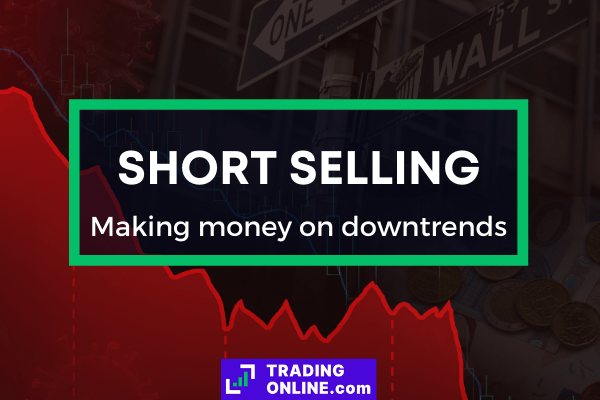
Short selling is a speculative strategy that focuses on the decrease of the value of financial security. An opposite strategy to the “classic” one, which instead involves betting on the rise in the value of a particular asset or security.
It is used to speculate on the price of a security that could be in trouble or in other cases – these are more relevant especially in articulated strategies – to hedge, that is to cover oneself from the risk of positions in inverse correlation.
With the arrival of CFD contracts contracts also on the retail investment market, short selling is available to everyone, even to very small investors and – although traditionally considered a tool for more experienced traders – it can be used within certain strategies.
Short selling – main features:
| 📈 Type: | Tool to profit from bear markes |
| 🎯Goal: | Speculating on downtrends, Hedging |
| 💰Commissions: | Spread, interests and/or fixed commissions |
| ⛔Risks: | They depend on the underlying asset – average to high |
| 🥇Best brokers: | eToro, Capital.com, Trade.com, Iq Option |
| ⚡Available with DMA: | Depends on legislation and brokers in your country |
What is short selling: definition
Short selling is the sale of securities that we do not have in our portfolio, in order to bet on their decline. A complex system, but today it is made much simpler due to the fact that it is offered by several brokers for online trading.
- Sale of securities that we do not have in our portfolio
When we decide to proceed with short selling, we are actually technically selling securities that we do not have in our portfolio. We are borrowing them in order to sell them now and buy them back in the future for a profit.
- Low-balling
Short selling exists because it allows you to bet on the decline of a specific security. If we think, for example, that soon gold will lose its value in the markets, we can open a short sale position to bet on the fall of the price.
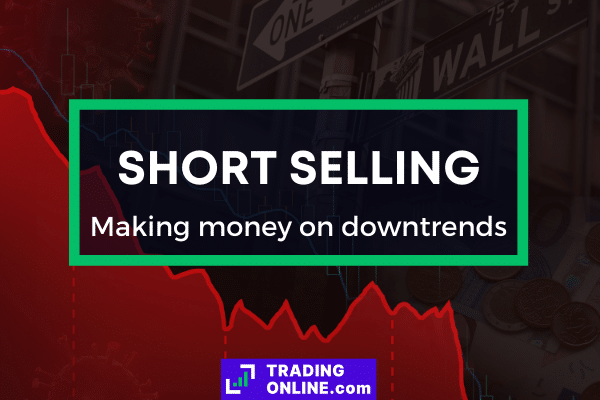
Technically, with the short sale, we are selling gold today that we do not have, in order to reintegrate it with a future purchase. If the price of gold falls in the meantime, we will have made a profit. If the price of gold goes down, we make a profit; if it doesn’t, we make a loss.
- Margin investment
Short selling belongs to all those investment instruments on margin, i.e. investment instruments created to allow us to take a position on the markets by covering with actual capital only a part of the required capital. In this sense, it is the equivalent of leverage, with which many of our readers are already familiar.
- Leveraged investment
The possibility of short selling with leverage depends on the legislation in force in each country. In Europe, ESMA is the body responsible for regulating this aspect; in the United States it is the SEC, in the UK the FCA, and so on. The technique of short investment in combination with leverage is often used mainly for hedging purposes, i.e. to cover the risk of other positions.
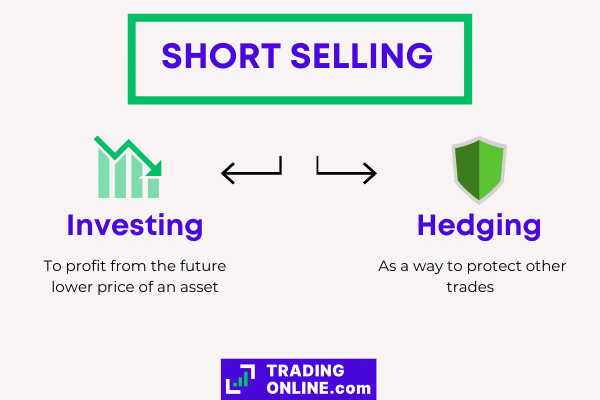
- Using derivatives
Often the most convenient way to invest short in a certain financial instrument is through derivatives. Today you can comfortably choose between several brokers offering CFDs (contracts for difference) that offer this type of service. CFDs constantly follow the quote of the underlying instrument but have much lower commissions especially when it comes to short selling.
What is it all about?
In reality, behind short selling, there are complicated procedures, which it is good to be aware of in order to understand what happens every time we operate with short positions.
- We are borrowing a security
Actually, when we operate with a short sale we are borrowing the security in question. Let’s imagine that we want to bet on the decline in Apple stocks. When we open a short position we are borrowing the Apple stock itself from a third party. This first step is the least intuitive, but it will surely become clearer after we analyze the next steps of the short sale.
There is an exception to this rule, or at least there used to be. It is called “naked short selling” and it allows the trader to short an asset that he has not previously borrowed. This is now banned in most legislations, though there are still countries that allow it for big financial institutions.
- The security is sold immediately
The security or securities we have borrowed are sold immediately on the market and, even if we do not see it, the sum we have obtained is set aside by the broker. It will be used later to repurchase the securities to be returned to those who lent them to us.
- At the closing of the position we buy back the securities and return them
When we close our short-selling position, the broker will buy back at market prices the shares we borrowed and return them to the original owner. This is the final step that allows us to understand how short selling actually works at least in its original form.
If we have borrowed 10 Apple shares for a total of 2,000 USD (the value is an example) in price at the time we open our short position, two things can happen.
If the total price of the borrowed Apple shares will be higher than 2,000 USD we will have to spend more to buy the same number of shares and we will have recorded a loss. Let’s imagine that Apple’s share price is now 220 USD each. To buy 10 shares we will have to spend 2,200 USD and will therefore have lost 200 USD.
Alternatively, if the price has fallen, we can buy the same number of Apple shares at a lower cost and therefore make a profit. Let’s imagine that Apple shares are worth 180 USD each at the time of closing our short order. We will have earned a 200 USD profit because to buy the 10 shares to return, we will actually have spent 1800 USD.
This mechanism can be amplified if you levarage your traders. In the first example, if we shorted 2.000$ of Apple shares using a 2X leverage, we would be shorting 4.000$ worth of shares overall. This means that, giving the same increase in the stock price, we would have lost 400$. In the same way, in the second example we would have made a profit of 400$. It is important to remember this fact, given that most short positions are carried out on margin.
- CFDs make this process obsolete
The process we have just described is actually something that is outdated and not practically used anymore. CFD brokers offer a procedure, for this type of operations, which is much simpler and does not involve buying, borrowing and selling. This is convenient for the sake of simplicity, but also for the commissions involved: short-selling CFDs is way cheaper than doing so with actual shares or other underlying assets.
When you choose to invest short via a CFD, you are simply betting on the inverse performance of the security that we have chosen as the underlying. It is a contract between us and the broker in which each agrees to pay the other the difference between the current price of an instrument and the price at the time we decide to close the position. If the price has fallen we will gain, otherwise, we will lose out.
- Short selling in Forex
In Forex short selling and related positions are much more common. The process is exactly the same, which is what we described at the beginning. When we go short EUR/USD, we are betting on the rise of the USD against the Euro. In the world of Forex, short selling is absolutely structural. To make it clear, opening a short position on EUR/USD is identical to opening a long position on USD/EUR. They are simply two ways of looking at the same operation.
How to sell short: some practical examples
Step by step we are going to analyze how to place short sale orders using four different online trading brokers and four different stocks and markets. The operation, which on paper may seem very complex, in fact, it’s relatively simple and still mirrors, even in difficulty, the classic orders of long positions.
- Short selling Amazon shares with eToro
Thinking that Amazon shares can grow forever is not plausible and in any case, the idea that sooner or later they will surely have to return to lower price levels is starting to circulate, at least among some specialists. Let’s see together how you can sell short, without paying commissions of any kind, using eToro.
STEP ONE: In order to place a short sale test order on Amazon stocks we will need to open a demo account with eToro. You just need to choose a username, an email and a password. Then you will receive an email with a link. Click on the link to confirm your email account and you will immediately be granted access to the platform.
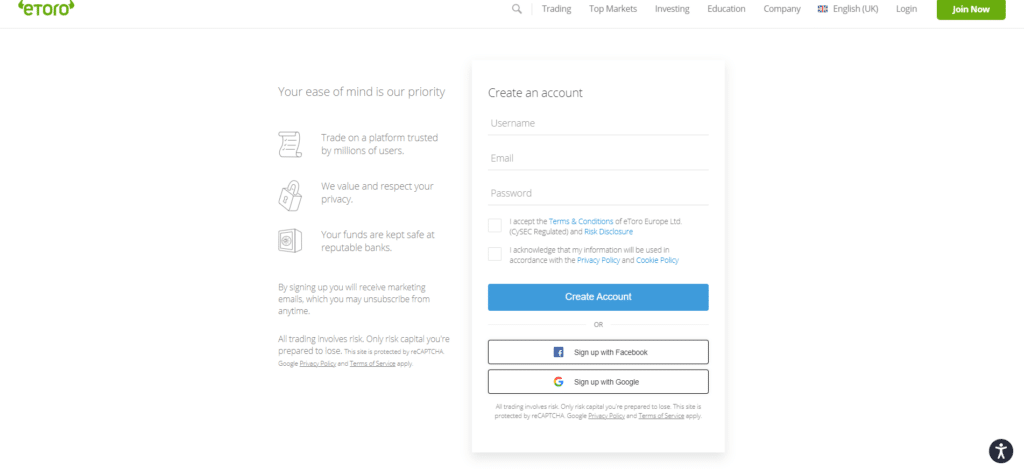
STEP TWO:We will now need to find Amazon shares within the eToro Investment Dashboard. Simply search for “Amazon” in the search bar at the top. After that, by clicking on the blue “Trade” button we will be able to choose all the details of our investment.
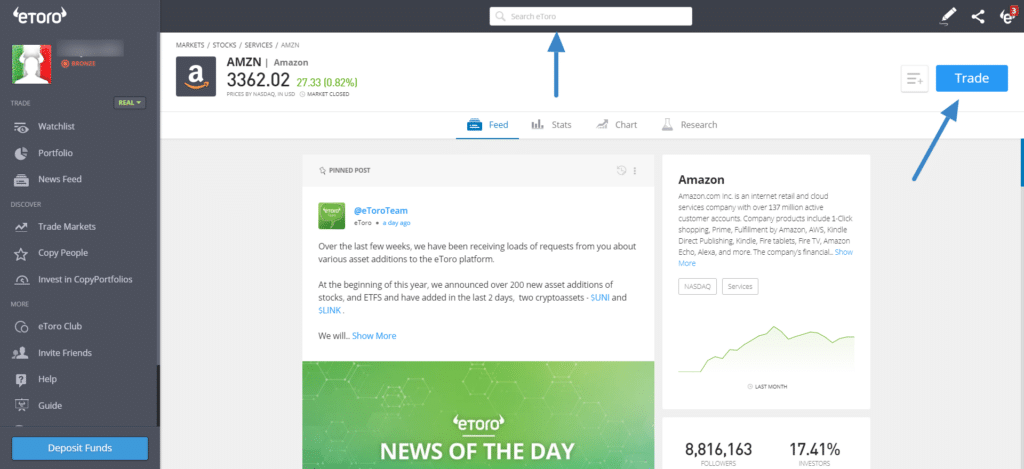
STEP THREE: Let’s choose all the details of our investment, such as the amount of money we want to invest and any leverage. Remember to choose “SELL” at the top, so we can invest in a short position. After completing the selection of details, click on “Open Trade” to open your investment.
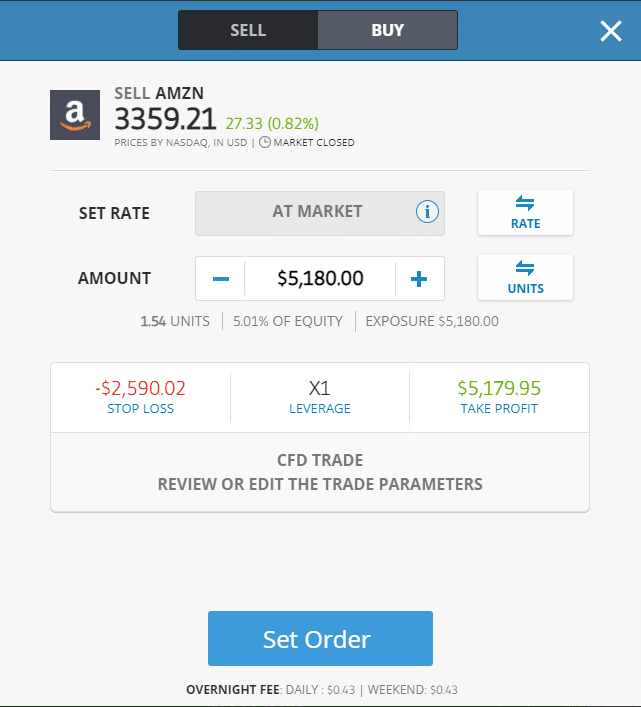
- Sell EUR/USD short with Capital.com
EUR/USD is the most liquid of the Forex pairs and by taking a short position we will have the opportunity to bet on the rise of the second component of the pair, that is in this case the US dollar. We will place this test order with Capital.com.
STEP ONE: Again, we will have to open a demo account with Capital.com. It is one of the easiest and fastest to open: we will just have to enter an email address and a password to access the platform. Once these details are entered we will have immediate access to the platform, but keep in mind that you will have to verify your identity to trade with real money.
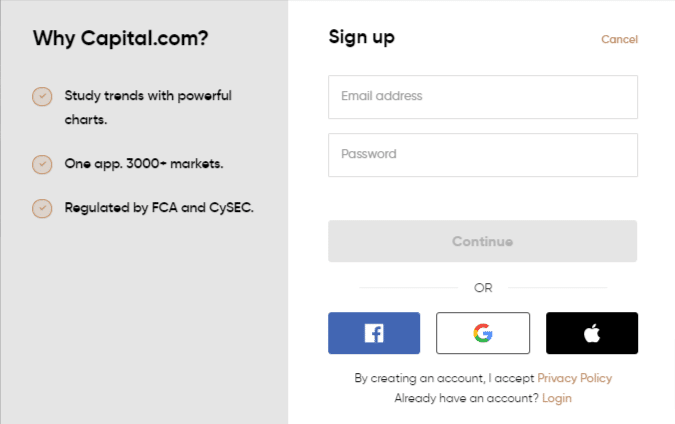
STEP TWO: From the Capital.com platform we will have to find EUR/USD. We can find it by scrolling down the menu, getting to FOREX and then choosing USD. On the list that shows up, as you can see in the image, it is possible to find EUR/USD. Otherwise, you can use the search bar as we did before on eToro. Now let’s click on the correct pair and choose SELL.

STEP THREE:We will now have to place the order. We will set the amount of money to invest, and we can also activate take profit, stop loss or order at a different price than the current one. When all the details are correct, just click SELL to open our short-sell position on EUR/USD.
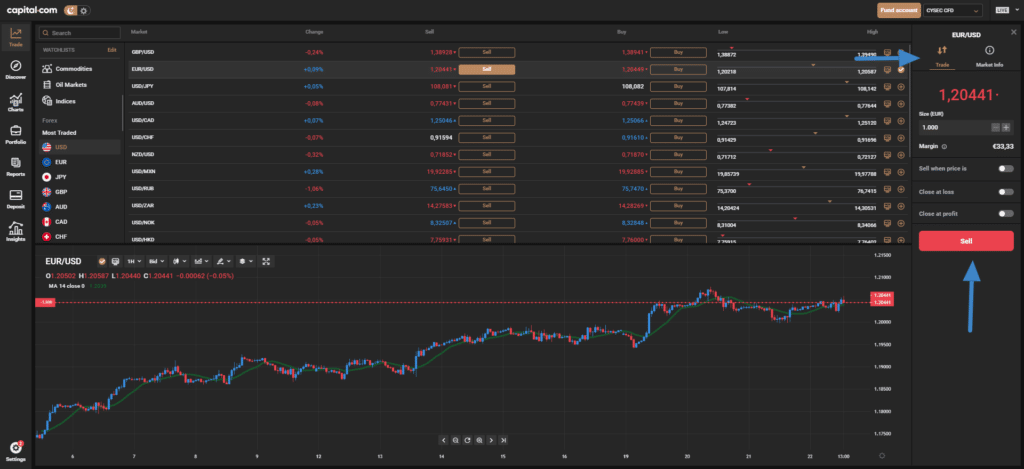
- Selling Gold Short with Iq Option
Gold has a strongly anti-cycle trend and can also have long recessionary periods at the price level, which opens important opportunities to trade short both for profiting and for hedging purposes. We will do so, in our test order, with IQ Option. This broker, which is available almost all over the world, is famous for having a very low minimum deposit (just €/£/$10).
STEP ONE: Let’s open a free demo account with IQ Option – an account that allows us to have access to virtual capital to test the platform’s functionality and also our trading strategies. Once on the registration page, click on OPEN AN ACCOUNT FOR FREE, enter a valid email address and password. Then click on REGISTER. We will be automatically directed to the IQ Option web platform.
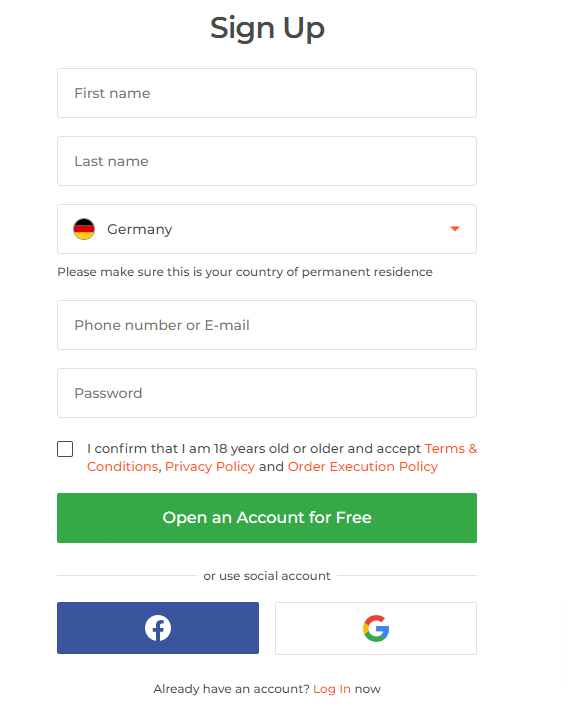
STEP TWO: Now we will have to get to the Gold chart, from which we will place our order. Let’s click on “+” at the top, then go to “Commodities” and then “Gold“. Let’s click on it to access the chart that you will see on a screenshot right after this paragraph. On the right side, we will be able to place the order details.
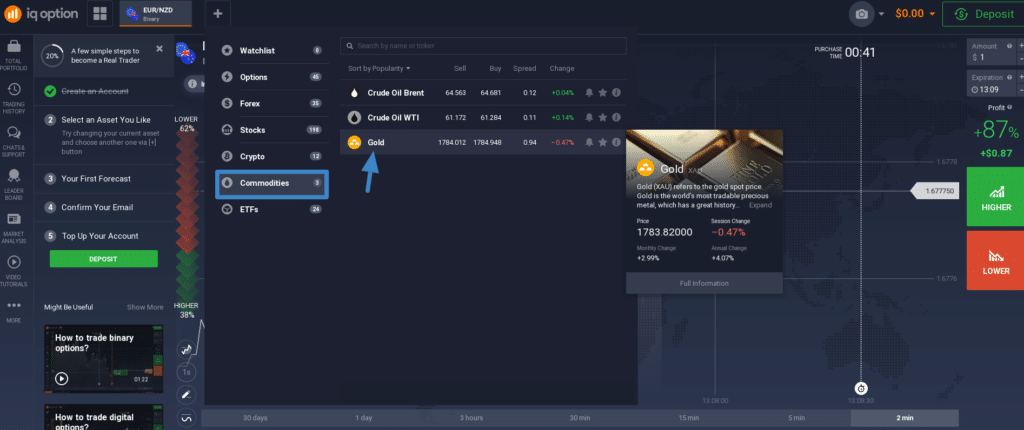
STEP THREE: Here we can set the amount of money to invest, the leverage to apply and other details. When the details of our order are correct, we can execute the short sale by clicking SELL. In the “Portfolio” section you will be able to monitor all your open orders and close them whenever you want.
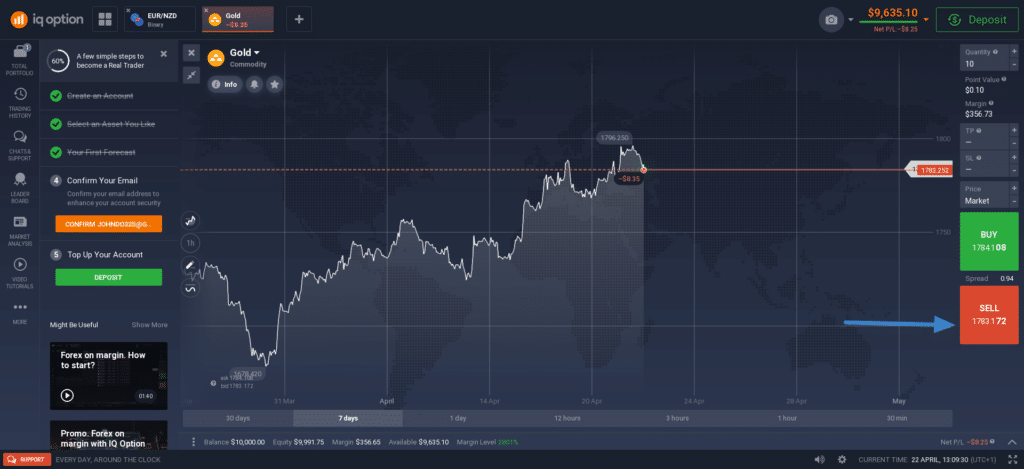
- Sell DAX 30 short with Trade.com
DAX30 is the index that allows you to invest in the 30 best stocks that are listed on the Frankfurt Stock Exchange, in Germany. To sell this stock short, we will proceed with Trade.com, a multi-asset broker that has always offered the possibility to operate also with leverage.
STEP ONE: open a demo account with Trade.com. Enter your First Name, Last Name, Email and Phone number to switch to the free demo account with virtual capital. Once we have entered these details, we can switch to the platform by clicking on “Create Account”.
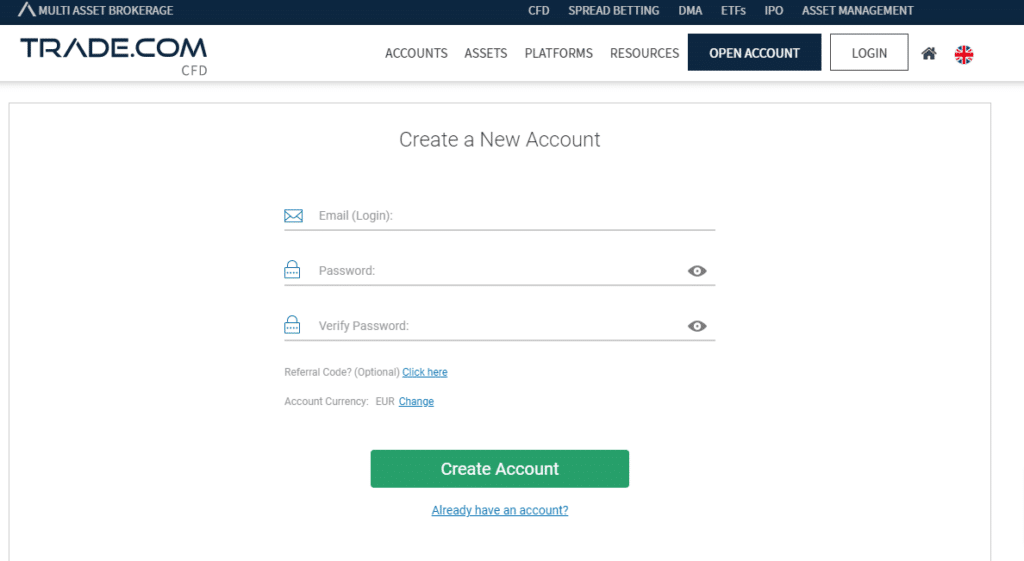
STEP TWO: We have already been redirected to the trading platform of the broker Trade.com. We will now need to access the DAX chart, available from the “Indices “ menu on the left. We then click on “Germany 30”, with which the broker signals the DAX 30 and we will find ourselves in the chart that we attach to our guide right after this paragraph.
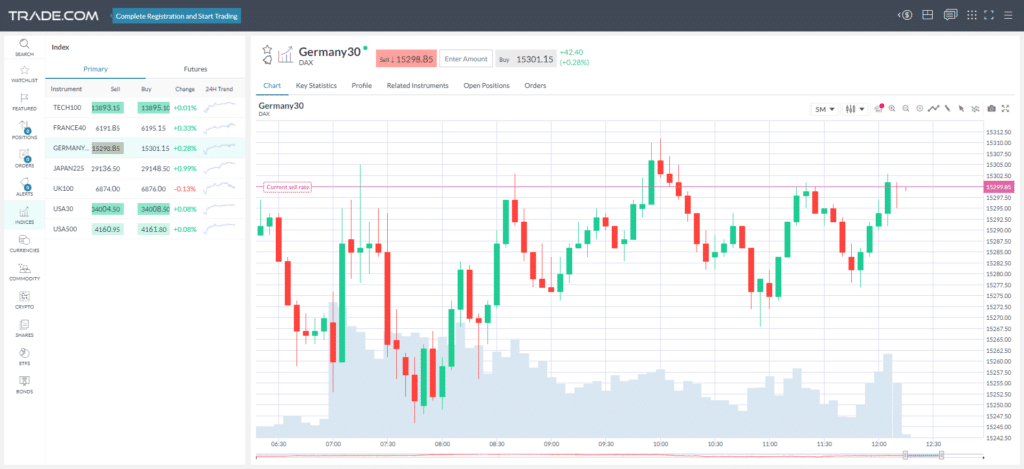
STEP THREE: let’s place the short sale order by clicking on SELL and completing the details of our investment. Also here we will be able to set take profit, stop loss, as well as other types of details such as the order triggered at a certain price level. We click on INSERT ORDER and we will have placed our first short sale order on Trade.com and DAX30.
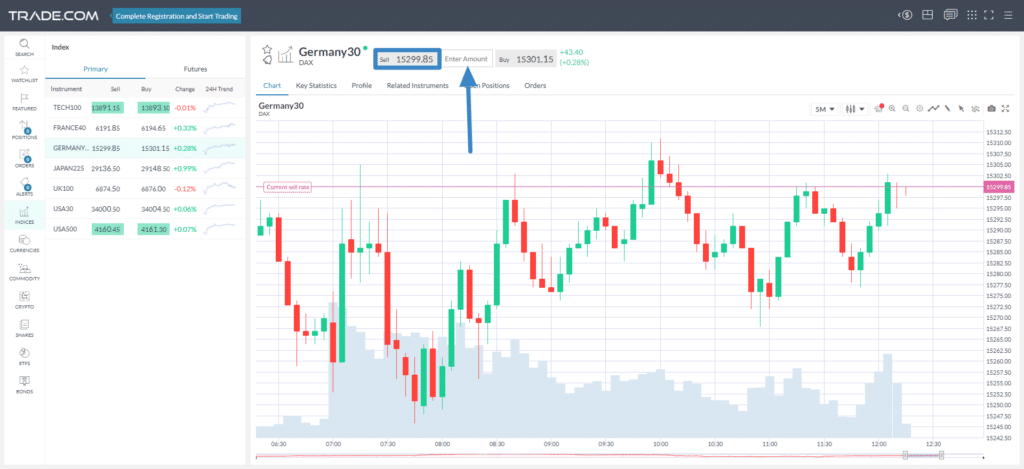
Where to do short selling: best platforms
[broker]
After the table, let’s get to know more closely what are the features of the best brokers for short selling.
eToro is a mixed CFD and DMA broker that offers short selling on all securities in its offer, which is currently over 2,100. Like all CFD brokers, it applies a double commission, namely the spread and overnight commissions. When comparing these two costs with the market average, they appear to be very convenient.
eToro is a European broker with a regular license, which permits as we did just above to open a demo account at zero costs. In this way it also allows us to test our trading strategies with short selling using virtual money, thus running fewer risks. Definitely one of the best brokers overall, with a particular convenience when it comes to short selling. Not only for the tight spreads, but also because it allows you to manually select the leverage you want to use on your trade, giving you more control on your investments.
For those who want to combine this type of operation with more classic trading, it is worth mentioning that eToro also offers zero commission shares, in DMA mode, on the same platform and with neutral access to all major markets around the world. At least for now, however, you cannot short real stocks using eToro.
Note for U.S. Traders: even if eToro is available in the United States, CFDs cannot be offered to american investors. Giving that eToro does not allow traders to short-sell real stocks, U.S. traders do not have the possibility to open short positions to this date.
Capital.com is a pure CFD broker, duly licensed by the European Union and with over 3,000 stocks on its lists today, all open to short selling.
Also in this case, as with the previous one we mentioned, we have a broker that offers this type of instrument with ease and at a very low cost, in order to have all the instrumentation that was once only available to professionals. We can also count on an A.I. powered by Capital.com that analyzes or trades to give us personal suggestions on how to become more profitable.
Capital.com provides its clients with three different platforms: the one it owns, developed by the broker itself, Metatrader 4 and TradingView. You can test Capital.com in demo mode (free and unlimited), with no costs included and without any kind of obligation to switch to a real account later.
Trade.com is a multi-asset broker that also offers a very rich CFD section, with over 2,300 securities to invest in. Trade.com’s free demo account offers access to its own proprietary web platform, which allows you to invest with virtual capital and at no additional cost.
With this broker, you can trade stocks from all over the world and many commodities, for the world of Forex currencies and also for indices and bonds, as well as cryptocurrencies. If you want to focus on futures, you have one of the most complete lists of tradeable futures that you can find on an online trading platform.
A complete broker that allows us to make all the experience we need without costs, and then eventually switch to the real account and also use MetaTrader, the best possible platform for online trading, at least according to specialists. If you choose to trade on Metatrader, the number of assets you can trade will be restricted; to compensate for that, you will be able to access exclusive features such as automatic trading signals and algo trading.
IQ Option owes a significant part of its popularity to the fact that it is the only broker in the world that offers real accounts with only 10 euros, pounds or U.S. dollars of investment. A particularly low sum, which allows everyone to have access to professional trading equipment.
It offers short selling on the selection of securities – small but of quality – that it makes available to its clients. It will not have the thousands of stocks we have seen with the other brokers mentioned, but it still offers great spreads on Forex, stocks, commodities and cryptocurrencies. Here you can open a demo account with IQ Option and start trading with 10,000 USD of virtual capital.
Depending on the country where you declare to reside, you may also be able to trade binary options on Iq Options. For example, French traders can not access this asset class as European laws do not allow brokers to offer binary options to retail traders. In most of Central and Latin America, as well as in some Asian countries, they are still completely legit and available on the platform.
The equivalent of a short sell using CFDs, when using binary options, is a PUT option. In this case, you will be rewarded if you successfully predict the downfall of a financial asset. Keep in mind that binary options are more speculative and potentially riskier than CFDs, so you should be even more careful.
Learn how to short sell
You can learn how to do short selling with books, video courses and trading courses: it is such a basic topic that it is covered by practically any kind of market guide, although not all of them can be considered as equally valid. For this reason with our editorial staff, we have decided to propose a guide that is able to explore the topic with concrete and factual information.
Top short selling books
Short selling is one technique of many that we can implement to manage our portfolio. Therefore it becomes very difficult to find books that deal exclusively with this topic. This is not so bad, because we can find specific insights on the subject in very interesting books about the world of trading.
- A Beginner’s Guide to Day Trading Online by Toni Turner
A simple book that covers all the basics of online trading, including short selling. The book is designed for novice traders who want to learn how to do speculative online trading, also taking advantage of investments on the downside of financial instruments. Since it was first published, it has been a best-seller. In 2007 a new edition came out, that is still today one of the 50 most read books about economics in the United States.
- How to make money selling stocks short by William J. O’Neil
A book entirely dedicated to short selling, how to use it in the best way in your investment strategies and its role in the financial markets. A manual of a more technical nature, which closely analyzes the characteristics of a stock on which you can successfully make a short sale investment. Balance sheet data, fundamental analysis and other topics requiring intermediate financial market expertise are mentioned.
- Short Selling for the long term by Joseph Parnes
An unconventional book that approaches the topic of short selling from a unique perspective. Many, including us, find this tool useful primarily for the short term. Parnes’ approach is contrary and it is absolutely recommended for those who want divergent, but intelligent, opinions on short selling. What we like most about this book is how it manages to focus on the bright side of short selling. It shows exactly how the markets overprice some assets, and how short-sellers can take advantage of them and make the markets more efficient at the same time..
Short selling video courses
Even free video courses can help us to understand the real magnitude of the world of short selling. We have selected three videos to further explore the topic. All videos use a different approach, but they are all very simple.
- How short selling works di The Plain Bagel
The Plain Bagel has one of the best informative channels on Youtube. It deals with the world of financial markets from every point of view, including the basics of short selling. In this short video explains the mechanisms we talked about in the guide, with the addition of some animations that make it very entertaining.
Before watching the video, we have to inform you about a controversial point that is discussed towards the end. The author claims that when an investor shorts an asset, he can virtually lose more than he invested. This is not the case anymore, at least in most countries, as brokers must legally protect traders against negative balance.
- How to short a stock di ClayTrader
In this video of about 20 minutes we get to the practical aspect. The author shows you how to invest short on AT&T stock, showing every practical step you need to follow to execute the trade. It’s the same steps we’ve seen in our examples, but with one difference: instead of using a CFD broker to avoid commissions, ClayTrader sells short actual shares. In Europe, in the UK and in Asia it is quite uncommon for retail traders to short sell un underlying asset.
In the USA, this is different. Although you cannot do naked short sells (short selling without actually borrowing the asset from someone), you can short sell actual stocks with reasonable commissions even without using derivative contracts.
- Why is short selling legal? by CNBC
This video was made by CNBC right after the whole world stopped talking about what happened with Gamestop stock. In case you missed it, some Reddit users cooperated to massively buy shares of Gamestop, a chain of stores dedicated to gaming, whose stock had been heavily shorted by some hedge funds. Reddit users managed to skyrocket the value of Gamestop’s shares, leading even the mainstream media to talk about short selling.
The video is very basic, as it is targeted at an audience of first-time investors. The cool thing about it is how the story of Gamestop shares is narrated in the background: being one of the weirdest moments in the recent history of financial markets, we really think that traders should know at least the basics of what has happened.
Short selling opinions and reviews [2021]
Short selling is a useful tool available today to traders and savers with non-speculative strategies. Here we have collected the trading opinions of our editorial staff, as well as those of third parties that we can consider reliable and that may offer insights for further exploration of the topic.
Is it worth trading short?
Short selling should be seen as an additional tool that we have today to trade online and to make a profit even in situations where the market falls.
We also share the opinion of those who say that short selling is a tool for experts, for traders who have already gained some experience and know-how to operate using advanced tools. A certain level of experience should also be required by those who invest in the opposite direction, i.e. betting on the rise of security.
Even if the markets remain in a bullish phase for longer than they do in a downward phase, even when investing on the upside of equities one must be aware of the risks.
To stay strictly on the convenience of short selling, brokers today offer low-cost CFDs, which has made short selling effectively accessible to everyone.
Moreover, the complex procedure we have described in the initial phase of this study is now automatically handled by the trading platforms: we do not have to worry at all about finding counter-parties, borrowing securities, etc. This also helps to make the tool convenient.
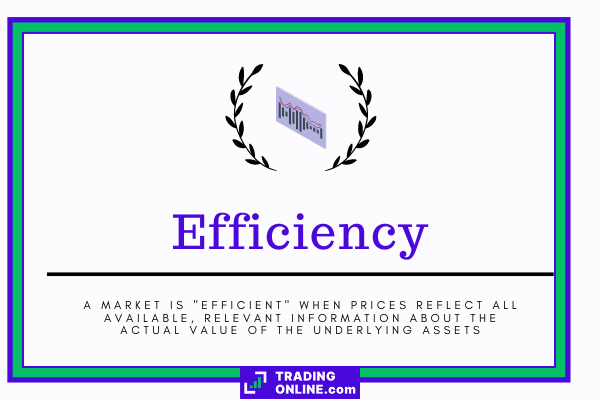
Short Selling: Pros and Cons
Short selling definitely has pros and cons that must be evaluated before using the tool and especially before you decide to integrate it into your strategies. We will analyze what we believe to be the advantages and disadvantages of this specific tool also in order to offer our readers a clear analysis of what happens when we operate with short selling.
Advantages of short selling
- Excellent system for hedging
The practice of hedging allows you to hedge against risks for investments that have an inverse correlation. The typical example is that of a short position on EUR/USD – and therefore short selling of US dollars – to protect oneself from the exchange rate risk of an investment in US stocks. We could give hundreds of other examples to illustrate the additional usefulness of short selling in this regard.
We believe that the use for hedging purposes is indeed one of the main and most useful – which can only be at least in our opinion the biggest advantage of using short selling.
- Earn money while the markets are falling
There are many examples of financial market crises. It is no longer even necessary to recall the subprime mortgage crisis in 2008/09. The crisis due to the COVID-19 pandemic has reminded everyone that there can be periods, even relatively long ones, during which markets fall.
Short selling allows you to have a useful tool to invest in the stock market even in these moments of turbulence while investing on the upside during a recession would result in easy losses. And this can only be a huge advantage offered by short selling.
Disadvantages of Short Selling
- A powerful tool
As much as freedom is always good, even for investors, mismanaging freedom can become a problem. Short selling today puts into everyone’s hands the ability to access complex positions that with leveraged trading can become very risky.
Some fail to manage this freedom and take the advantage of short selling to take unsustainable positions with a level of risk much higher than legal and reasonable. Like all tools that the world of online trading makes available, they must be used carefully.
- Borrowing Costs
As we mentioned, short selling involves a loan of securities or, in the case of CFD brokers, a loan for the money that keeps the position open. Interest is therefore charged to our account in the form of overnight fees. It is also true that due to the great competition between brokers these rates are very low.
In the world of CFDs, overnight commissions are always charged on positions. With short selling, however, the rates are lower than with long positions.
Short Selling: Recommended Forums
We would like to give a shout out to five forums that are an excellent starting point for discussions regarding short selling and trading. These are the forums that we think are the best because, in addition to in-depth discussions on these types of instruments, they offer many other useful discussions for those who want to trade in the right way.
Reddit has become a very relevant place for investors to share strategies and express their opinions. There are many sub-reddits where you can find comments and posts about short selling. The most prominent is r/investing, where you will find thousands of investors talking about short selling every day.
- Investing.com
Born as a website to access market data, it has become increasingly popular as a forum. There is plenty of room to meet other investors and talk about short selling on Investing.com. The most popular places to do so are under the price charts and inside the specific “forum” section.
- Moneyforums by Citywire
If you are looking for a very diverse forum, this one is for you. You will find threads about everything that involves money, from filing taxes to short selling. It is also a very popular choice among international users, making it easy to hear opinions from people located all over the world.
- Analystforum.com
Analyst Forum has a level of discussion above average. The target here is experienced traders who focus on short-term investing, which makes it a very good place to talk about short trades. You will almost certainly find interesting analysis and opportunities, which is why we really love this forum.
- MoneySavingExpert Forum
Another incredibly diverse forum, where users discuss everything from credit cards to speculative trades. We find it a good way to learn about personal finance in general, where short selling is discussed as part of the wider picture of the many ways you have to invest your money.
Our opinion on Short Selling
Our opinion is that supply and demand should not be limited: short selling is important for the markets and their proper functioning, and we are happy to have this tool available to small traders as well.
We believe that controversies about short selling and trading are pointless, especially when they come from authorities and governments that periodically block them, without any scientific grounds.
Those trading on the European stock exchanges, in particular, will also have noticed a block on short selling during the recent COVID19 crisis in the hope of keeping the prices of certain stocks artificially high. We are not alone in this struggle with regulator intervention in the event of a major crisis. There is a substantial body of scientific literature suggesting that the moral issue of short selling should be eliminated once and for all. Short selling is functional to the markets and enables them to establish a real and concrete price for each instrument.
We strongly oppose bans, even in the most heated moments of crisis, for the following reasons:
- Market Distortion Effect
Markets know how to do only one thing – their hive mind is able to price, very efficiently, any type of asset. Intervening by prohibiting short positions has distorting effects on this mechanism, reducing the efficiency of the markets with damaging effects on the entire financial system.
- The “positive” effects are extremely limited, while the negative effects are long term
The positive effects on stock prices, where they have occurred, have always been very short term. There are tons of data demonstrating that the price of shares in times of crisis tends to conform to what the market considers “right”.
- Slows down recovery
The short sale ban on a stock slows its recovery and lowers its trading volume. This is certainly not desirable.
So, are the authorities that intervene to protect companies listed on their markets wrong? In our opinion and in the opinion of the top echelon of financial researchers, yes. After all, “the road to hell“, as the old saying goes, “is always paved with good intentions“. The situation is different for the individual investor who wants to access this type of instrument via CFDs. In this case, the suitability must be evaluated on a personal level, taking into account various aspects concerning short selling:
- It is a more risky position
Because even during a crisis there are a lot of price rebounds, so you risk entering with a short position, being faced with a rebound, and losing almost all your capital. We are not talking about an easy way to earn money, but about a speculative investment like the classic stock purchase.
- It is generally a short-term position
It is almost useless, especially in the stock market, to bet with short selling for long-term investments. It is a fundamental rule of this instrument that we should never forget. Between the costs involved, the ability of stocks to incorporate inflation and long-term stock market trends, it is absolutely unreasonable to actually expect the price of a stock to go down forever.
Final considerations
Short selling is a tool that is often criticized but, at least according to our editorial staff, it should be respected both ethically and practically. We have investigated its possible uses, not only the speculative ones, and we have talked about how successfully it can be used.
This is to date the only one tool to offer profits when markets are falling and low-cost protection with hedging positions. The tool, which is now widely available also thanks to the arrival of CFDs in the market, can be a useful addition to the normal way investors operate.
Always keep in mind that there is technically no limit to the amount you can lose on a short trade, and that markets tend to rise over time so it’s harder to figure out when to short an asset. Beside these two factors, the is no actual reason for an investor to avoid this kind of operation. Short selling should be respected as a powerful way to make demand and supply for financial instruments meet at a fair price at any given moment.
What is short selling?
It is a trading tool that allows us to bet on the decline of any security.
What are the assets that I can short-sell?
You can practically short any asset, from Forex to stocks, through cryptos, commodities and even ETFs.
Is short selling risky?
Short selling is generally riskier than investing in the opposite direction, as there is no limit to the amount you can lose (an asset price could grow indefinitely) and because markets have the tendency to grow, not shrink, over long periods.
Which brokers offer short selling?
Almost all brokers that offer CFDs also have the option to short-sell these contracts, namely eToro, Trade.com, Capital.com, Fp Markets and Iq Option.
Is short selling difficult?
Nowadays shorting an asset is very easy. Most platforms only require you to click on “sell” instead of “buy” when you open your trade.
What can short selling be used for?
You can use it both for speculative trading and for hedging, i.e. hedging against the risk of other positions to protect you from certain market conditions.
How much capital is needed to invest with short selling?
You need the capital to invest on margin and hedge price changes. Some online trading brokers, such as IQ Option, allow you to start with as little as 1 euro per position and a 10 euro minimum deposit to open an account.
Guide
CFDs: what they are and how they work
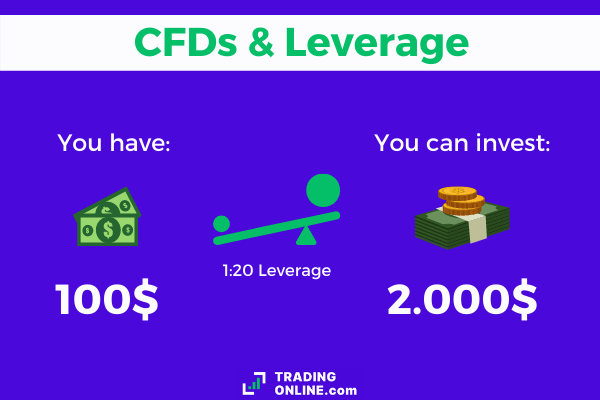
CFDs (Contracts for Difference) are derivative financial contracts that replicate the performance of another asset and allow you to invest against a Market Maker broker without ever passing through the underlying asset itself.
They represent a complex and particular instrument, which has had (and in all likelihood will continue to have) enormous success in Europe and Asia – in the USA, however, it is banned from the retail market – because it allows leverage and, above all, access to different markets at the same conditions. Born as an instrument used mainly by hedge funds, today CFDs are a financial product accessible to all and that can be used even by those who operate for the very first time on the markets.
Main CFDs features:
| ❓Type of asset: | Derivative with no deadline |
| 🛠Allowed: | Leverage & short selling |
| 👍Broker: | Best Online Trading Platforms |
| 📈Markets: | Stocks, Forex, Commodities, ETFs, Indices, Bonds, Futures |
| 💷Fees: | Spread and Overnight fee |
| 💰Investment: | You can start with as little as 10/20$ |
| 💪Regolator: | ESMA (Europe), ASIC (Australia), FCA (UK), |
| ⛔Risks: | Subject to leverage |
What are CFDs
CFDs are derivative contracts that allow you to invest on margin, replicating the price trend of an underlying asset. They are derivative contracts and are typically traded outside official exchanges, therefore in OTC (Over The Counter) mode.
This is the “scholastic” and traditional definition, but for those who are not already experts in financial markets, it is quite difficult to understand. That’s why we want to start with the basics and see all their features in a simpler and more intuitive way.
CFDs are:
- Derivative contracts
Like Futures and Options, contracts for difference are also derivative contracts. In fact, they do not involve the purchase or sale of the underlying asset, but simply of a security that replicates, with certain mechanisms, its value.
When we buy a CFD on Apple shares we are not actually buying Apple shares, but a contract between us and the broker, which follows the trend of the stock. In reality the mechanism is much more complex, at least behind the scenes, but we will get to that with the analysis of the other peculiarities of this contract.
- Suited for margin investing
CFDs are margin investing instruments. When we open a CFD position on Amazon shares for 1,000 USD, we do not have to pay the full amount, but only the margin to cover it. If we choose to trade without a margin, the coverage will necessarily have to be 1,000 USD. by choosing a margin of 50% – i.e. a 1:2 leverage – we will be able to cover the entire investment with 500 USD. If we choose 1:5 leverage – which is the maximum allowed in Europe, for example – we will only need to cover 20% of the position, in this case 200 USD.
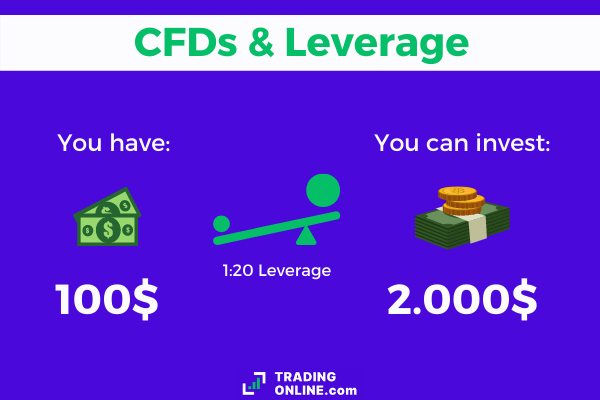
Different jurisdictions have different rules on leverage. While in the United States it is not allowed to trade leveraged CFDs, in Europe it is possible to invest in stocks with a leverage of up to 1:5. In Australia, on the other hand, as well as in other countries it is possible to reach a leverage of 1:50 on stocks and even 1:200 on Forex.
At TradingOnline.com we have selected and reviewed all the best brokers that allow their clients to trade through CFDs:
- eToro (here for the official site)
- FP Markets (here for the official website)
- Capital.com (here for the official site)
- Trade.com (here for the official site)
Being able to trade with leverage makes CFDs attractive to investors who do not want to lock up all the liquidity they need to conduct their trades. The margin however, as we will understand more clearly later on, is also a risk multiplier, because each movement of the security will multiply by the leverage we have applied, both positive and negative.
- Replicate the price of the underlying asset
Throughout its lifetime, that is, until we decide to close the position, the CFD will follow the trend of the asset we want to, albeit indirectly, invest in. When we choose a CFD on Ethereum (yes, cryptocurrencies can also be hedged with CFDs), we get a price at the opening of the position, let’s imagine 350USD.
As the real value of Ethereum moves, the value “carried” by the contract also changes. For the performance of our capital, net of margin, holding a CFD or holding the underlying asset is virtually identical.
Minor differences can occur when the supply and demand for a certain financial instrument are very different between the exchange where the instrument is listed and the broker you are using to trade CFDs. Especially in very “hot” moments, such as after the Brexit referendum, it is difficult for a CFD to replicate the exact value of the underlying instrument moment by moment. The difference remains small in any case.
- Traded in OTC mode
CFDs are typically Over the Counter instruments and they are not traded on regulated exchanges. OTC products are products that are not traded on a public exchange, but typically between the dealing desk (i.e. the broker) and the client. This means that the contract, being a derivative instrument, is between us who invest and the broker who has made the contract available to us.
Some states have tried to offer regulated markets to trade CFDs on the secondary market as well, imposing draconian regulations with the aim of making the market more transparent. However, very few have moved to this type of channel, mainly due to the obvious increase in transaction costs associated with such a solution.
The OTC mode can be a problem because it presupposes on the part of the investor full and total trust in the broker who also acts as a dealing desk. The CFD contract is literally a contract between two parties and there is no intermediary, state or otherwise, to standardize such contracts and above all to verify the solvency at any time of the contract in place.
A broker might sell you the CFD on a certain financial instrument, but no longer have the money to buy it when you decide to sell it. That’s why there are financial authorities, such as ESMA in the European Union, FCA in the UK and ASIC in Australia that oversee brokers. Their job is to make sure brokers remain solvent at all times and that they have insurance that covers their risk of insolvency.
However, we will be able to discuss this issue in greater detail when we look at the risks involved in this type of investment.
CFD definition
“CFDs” stands for Contract for Difference. The definition, however, aims to clarify only one of the fundamental aspects of this type of contract, namely that they are contracts that operate primarily on the difference in price between the current value of the underlying (the spot price) and the value at the time of closing the contract.
The most ignored part of the definition of CFD is the one related to the contract: we are in fact in front of a negotiation between two parties, that is between the broker and us. This contract is only between us and our broker: unlike real stocks, we cannot buy a CFD from a broker and then sell it to another person or another broker.
This feature of CFDs opens up several questions:
- They are not all exactly standard
As we mentioned, very small differences can occur between the market price and the CFD price. Although most jurisdictions have regulations on this aspect, it is possible that two different brokers, at the same time, have two slightly different prices for the same CFD.
- The broker is our counter-party
And this is what the detractors of Contracts for Difference focus on the most. Because on the one hand the broker is technically betting against us and because on the other hand he has to be the one to honor the contract we have opened. We are not in the sea of actual financial securities, where the security is worth owning and can be sold to third parties. CFDs only have value between us and the broker who issued them. They are precisely a contract between two parties.
How CFDs Work
After having analyzed the didactic and scholastic parts of these contracts, we are ready to understand how the instrument in question works, especially in everyday practice on the financial markets.
Why can CFDs be a good alternative to what is offered by the direct purchase of securities? Because they present particular characteristics that offer operativeness and tools that classic trading without derivatives and underlyings cannot offer.
- Investing on margin
It is very important, since the first appearance of this type of contracts. It should be remembered that CFDs have been widely used, especially by hedge funds, because they allowed them to cover important positions with a minimum capital commitment.
Leverage is as powerful as it is risky, because it allows you to technically invest capital that you do not have. The price difference on the leveraged investment, however, is directly reflected in the capital we have actually invested.
So if we invest 100€ on EURUSD, with 1:30 leverage, we will be exposed to the market for 3,000€. A variation of 3% in the value of the pair would mean a variation on our capital of 3% of 3.000€, or 90€. That would be 90% of the capital we have invested.
This can be very advantageous if the position we have opened is correct. We will almost double our investment with one trade and within a few hours. However, it is worth remembering that this multiplication is valid both ways, i.e. even if our position should be negative. Following the example above, we would have lost 90%.
- Short positions
CFDs also allow you to short-sell. All CFD brokers also offer this possibility, which allows you to bet on the decline of the underlying asset. Do we believe that Tesla shares will have a drop in the next few days? Well, we can buy a sell or short contract from a CFD broker and then close the position when the stock has lost enough value.
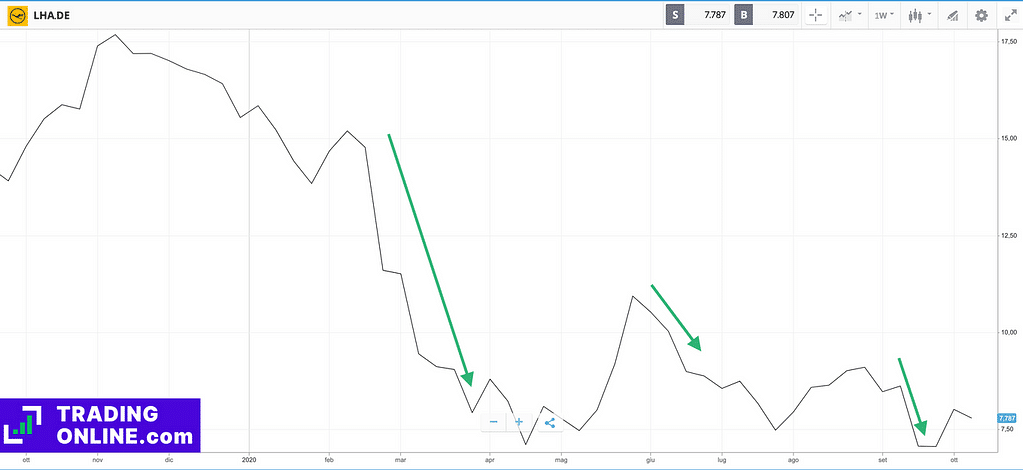
This possibility is impossible to achieve if not through the use of derivative contracts, of which CFDs are the most important representatives at least for those who access the markets on their own.
- Liquidity
When talking about the functioning of CFDs we must also talk about liquidity. Let’s talk about the market liquidity, that is the possibility of finding a useful counterpart for our purchase and sale. When markets are not very liquid, i.e. not very frequented by sellers and buyers, it becomes complicated to operate on the spot, i.e. with the certainty that at any time we can get rid of the position we have opened.
With CFD contracts instead, this problem is solved upstream: our counterpart will always be the broker who sold us the contract. The OTC system presents risks because the failure of the broker would result in the futility of the contract.
However, in almost every country in the world, the financial authorities have set very clear rules against this type of eventuality. For example, the fact that client deposits must be kept in separate current accounts from company deposits. Brokers must also show their financial statements to the regulator on a regular basis to show that they have sufficient liquidity to operate. Finally, most jurisdictions provide for mandatory insurance. The risks are therefore minimal in terms of liquidity, with absolute advantages for those who choose this type of product.
- What happens when we buy a CFD
There is actually a lot going on behind the scenes when we buy a CFD, although from the investor’s side the process is one of the simplest you can imagine, as it does not vary, except in small ways, from what happens with the direct purchase of securities.
- FOR BUYERS: when buying a CFD, whether in a long position or short position, we are deciding to buy a CFD, at a certain price level (which is the spot market price of the underlying asset), with a certain leverage for a certain amount of money.
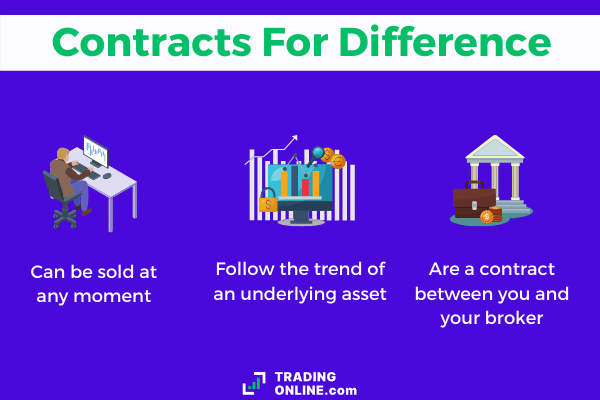
Practical example is buying $900 worth of NIO stock. From the moment we buy NIO it is trading at 45$, so a contract with 1:1 leverage will expose us to the value of about 20 shares. Instead if we choose to trade with 1:2 leverage, the contract will expose us to exactly twice as many shares, i.e. 40, and so on.
The following happens when the price of NIO changes: when the price changes, we will have to multiply the change and apply it to our real invested capital. If we had invested with a 1:2 leverage and the NIO were to rise by 3%, we would therefore have +3% x 2 = +6%. On the $900 we have invested this would be a gain of $54.
The process is identical for those who find themselves closing a position with a loss. A loss of 3% is to be multiplied by the leverage used and therefore by 2, in our example case, we would lose $45 out of $900 invested.
- FOR THE BROKER: the situation of the broker is much more complex, which can be skipped anyway for those who have no interest in understanding how CFDs work from both sides. The broker when opening a position is selling a contract, through which he commits to buying back the contract, resulting in the offsetting of any gains and any losses.
The contract it issues is valid only between the parties and with very rare exceptions – as for some brokers operating in the UK – it cannot be transferred to others via regulated markets. The broker to all effects is opening, contextually to ours, an inverse position. In case our investment is positive, the broker will settle it. In case our investment is negative, he will be the one to gain.
This type of functioning of CFDs is what makes them – according to skeptics of these contracts – unreliable and not transparent. The reality is that this does not affect the investor much, since beyond his interests the broker has to undergo important obligations for the exclusive protection of the investor as required by law in almost all countries of the world.
How to invest in CFDs
Technically we do not invest in CFDs, but we use this tool to invest in the underlying assets that are represented. Today there are several brokers that allow us to go and invest using this instrument, although in the United States they cannot be traded. On the other hand, Europe, South Africa, Australia and Asia are markets where almost everywhere CFDs are fully legitimate and they are used by millions of investors.
Several brokers propose a complete offer of products based on CFDs, allowing neutral access to all major markets. Therefore, it is enough to choose a good online trading broker (financial intermediary) that offers this type of contracts to invest via CFDs, with the modalities, caveats and above all the tools we have listed above.
Online Trading in CFDs / Trading Online in CFD
CFDs are instruments that allow you to operate by following both positive and negative trends. Their nature of derivative instruments in fact, allows a certain flexibility in decisions. In addition, they offer the possibility of using leverage.
Let’s start with the most classic position, the long one, which bets on the increase of the value of a certain asset. In this case CFDs behave in the same way as the direct purchase of securities. It will be enough to set a purchase order to have a derivative contract that will follow in every moment the official evaluation of the underlying instrument. In this case, closing the position we will have a gain in case the closing price is higher than the purchase price and vice versa.
In addition, it is possible through CFDs to short sell, i.e. to place on the market securities that we do not have in our portfolio and that are therefore “lent” to us by the broker. In this case we bet on the fall of the security, in an absolutely specular way to what we have seen with the Long position. Instead of trying to buy the securities at a low price to sell them at a high price, we will try to sell them first at a high price and then buy them at a lower price later.
Leverage plays an equally fundamental role in this mechanism: leverage in fact allows to amplify the trend of a security, creating a more pronounced volatility even on securities that are apparently very stable and on short-term movements of financial instruments.
This can be useful to those who want to trade in the short term, but not only: also those who invest in long term positions could find the multiplication of the trend of the assets on which they have bet useful.
How to trade in CFDs: some practical investment examples
We will now execute test orders, using a demo account, on different types of assets. We will place a test order on Amazon stocks, on oil as a commodity and finally on a Forex pair, EUR/USD.
- Buy Amazon Shares on eToro
eToro (official website here) is a broker for trading both with CFDs and directly with the underlying instruments. All major NASDAQ stocks are available in just a few clicks, including Amazon shares, the company headed by Jeff Bezos that has become a superstar on the American stock exchange in recent years.
- FIRST STEP: You will need to open a free demo account with eToro account which is completely free and can be opened in minutes. In the screen you’ll find – the same as in the picture below – you’ll have to enter a username, an email address, and your password. We have to accept the conditions by checking the two boxes and then proceed to create the account. Alternatively, we can also choose to sign up through our Facebook or Google account.
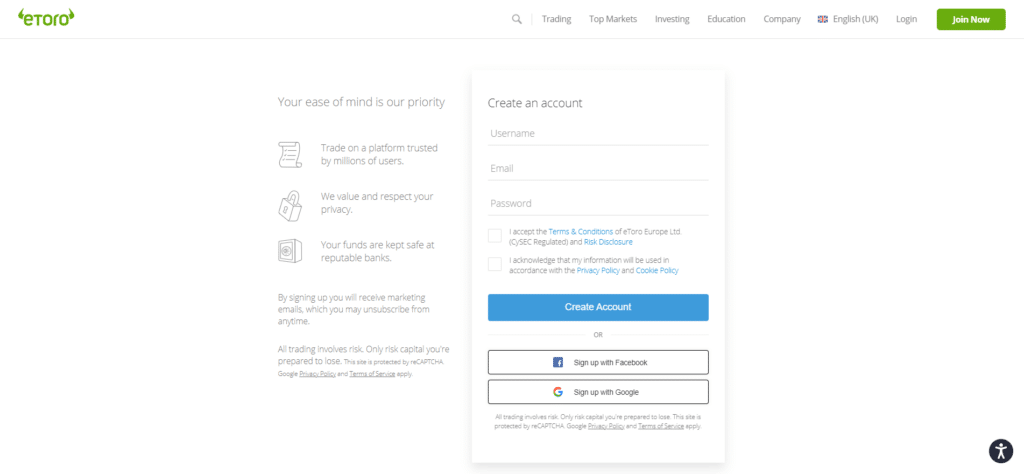
- SECOND STEP: We are officially registered on eToro. We login from the homepage, using the credentials we chose during the first step. We will then see a screen that is the main dashboard of eToro. On the left we will be able to select “Markets”, to access the different stocks. Let’s click on it.
- THIRD STEP: To access the Amazon stock you can navigate to the “Markets” page, or you can take advantage of the search bar at the top to go faster. Just search for “Amazon” and eToro will show you the stock right away.
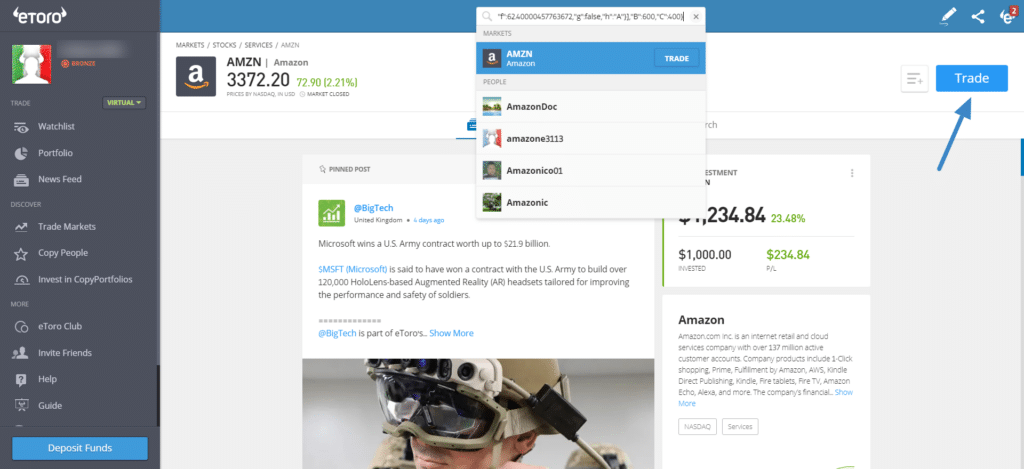
- FOURTH STEP: Placing the order is simple. Click on AMZN, then TRADE and you will see the Amazon stock order screen. eToro offers X1 leverage to buy real shares, while choosing a higher leverage you will trade CFDs. You can also choose to buy the stock right away or place an order that will be opened when Amazon shares reach the level you selected. By clicking on SET ORDER, our position will be officially opened to our portfolio.
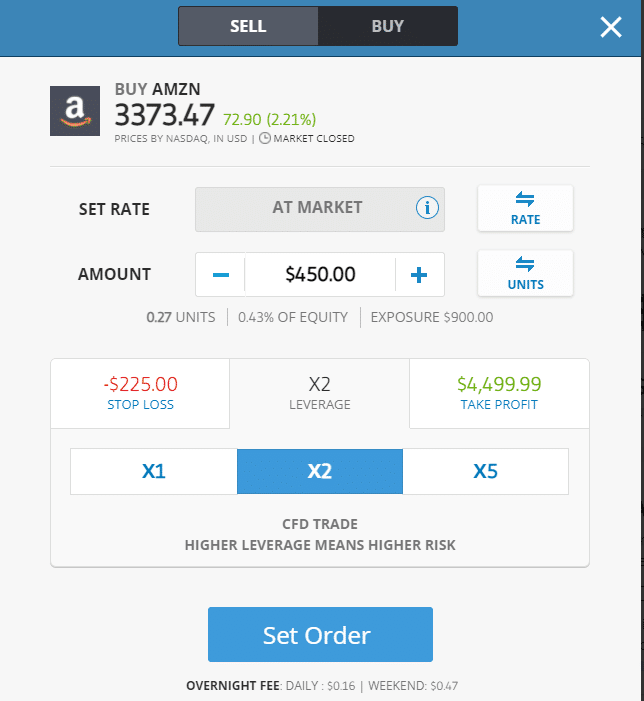
PLEASE NOTE: eToro only offers CFD trading to customers based where this kind of asset is fully compliant to local laws. US Citizens may not be allowed to trade on CFDs, but they can still use eToro to buy and sell regular shares.
- Buy CFDs on oil with eToro
With the FREE eToro demo account we have just opened, we can also proceed to buy oil CFD contracts. Since we have already opened our demo account, we will be able to choose the asset directly from the Dashboard.
- CHOOSE OIL: Again, you can simply use the search bar at the top and type “OIL” inside. eToro considers WTI oil as “oil” in general, as Brent is not tradable with this broker’s platform.
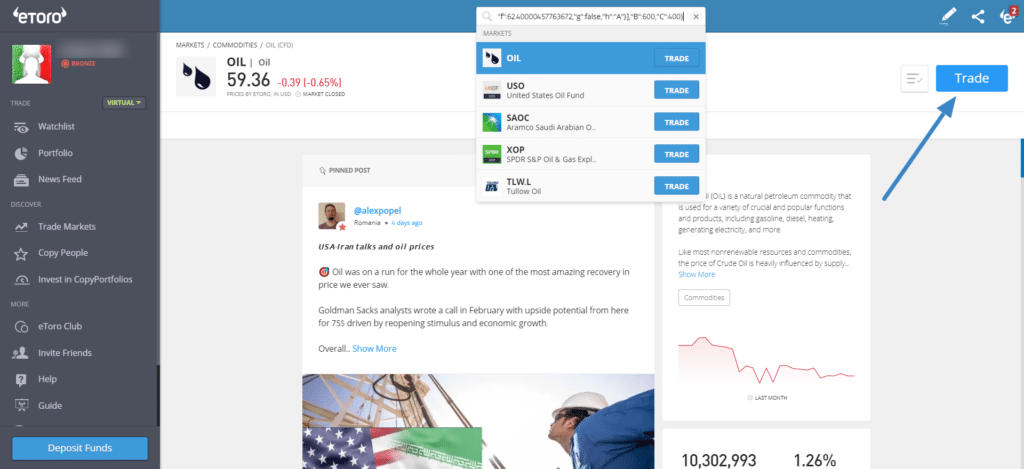
- PLACING THE ORDER: also in the case of placing the order, provided we have clear ideas, it is extremely easy. We will have to insert the volume again to invest, the stop loss and the take profit (not mandatory) and then click on OPEN POSITION.
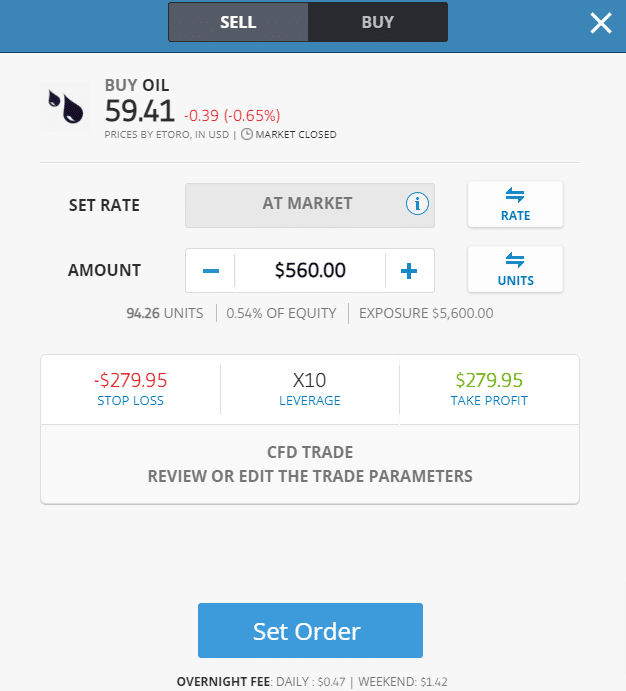
- Trading CFDs on EUR/USD with Capital.com
Capital.com is a broker that allows you to trade over 3,000 assets, including the most traded pair on the Forex markets, EUR/USD.
FIRST STEP: You can access Capital.com’s free practice demo account by simply entering the email and password you want to register with. After that, by hitting SIGN UP you will get instant access to the platform.
SECOND STEP: from the DASHBOARD, on the left menu, you have to select FOREX and locate the EURUSD pair. By clicking on “Sell” you’ll bet on a rise of the dollar, while by clicking on “Buy” you’ll bet on a rise of the euro.
THIRD STEP: to place your order, all you have to do is fill in the data of the small screen shown below. Enter the volume and set the stop loss and take profit if necessary. By clicking BUY, we can open our position.
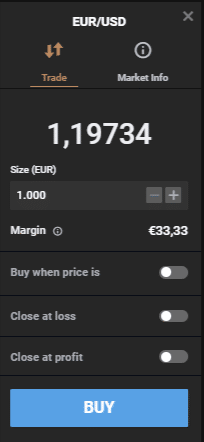
Where to trade in CFDs
[broker]
We have identified the brokers that offer the best conditions for trading CFDs today, taking into account the most important criteria to separate the adequate ones from the less adequate ones. The four indicated here are those that offer the highest level of reliability, the lowest commissions and the best access to the markets.
🥇 Best CFD Brokers
eToro is a broker that focuses on CFDs – alongside a DMA mode that allows direct buying on assets such as stocks, ETFs and cryptocurrencies. There are a total of 2,200+ assets, spread across Forex, stocks, commodities, cryptocurrencies, ETFs and index markets.
The platform is unique in its kind and it is accessible through any browser – even on Mac and Linux – directly online. There are many functionalities, but they are integrated into a platform with a consistent and easy-to-navigate interface.
CopyTrader is perhaps the most unique feature offered by eToro compared to the competition. It is thanks to this in fact that it is possible to copy traders on the platform, among those who have obtained the best results, with a single click.
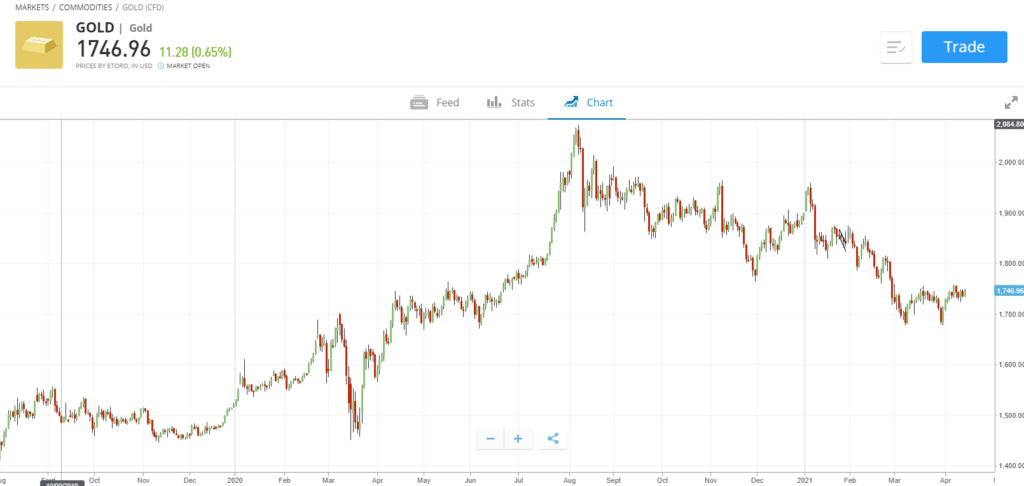
The typical tools of CFD brokers, such as leverage and the possibility to sell short, complete the framework. All markets on eToro are equally accessible: investing in US stocks has almost identical conditions to investing in other European markets.
The spreads are very competitive, especially on stocks – and the broker additionally offers a demo account for free, which can be tested without any kind of hassle and limitation with virtual capital of 100,000 USD.
Let’s remember the importance of the demo trading account: it allows you to trade in virtual mode, thus allowing you to learn this discipline, accumulating experience without using real money.
| Platforms: | Webtrader, App (iOS and Android) |
| Type of assets: | Forex, Stocks, ETFs, Commodities, Indices, Crypto |
| Tradeable assets: | 2.300+ |
| Main feature: | CopyTrader |
| Official Website: | https://etoro.com |
Capital.com is an exclusively CFD broker, licensed to operate in Europe in the UK. It offers thousands of assets, spread across the markets of Forex, stocks, commodities, cryptocurrencies, ETFs, indexes and even futures.
Also in this case, the broker offers a platform accessible via web and also via the App both for iPhone and Android devices. In addition to the Trading App, there is also Investmate, a platform created for educational purposes and which offers the possibility to learn directly from case scenarios that have actually happened in the real world.
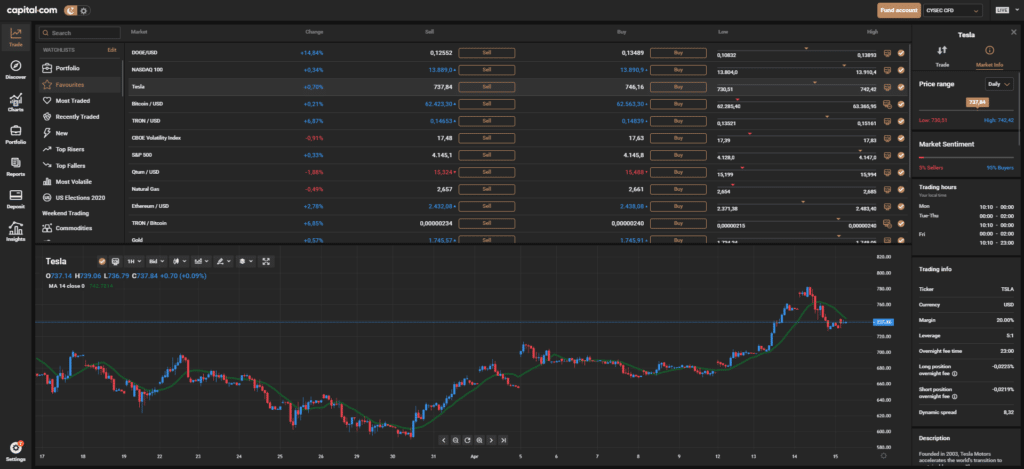
Capital.com offers a free demo with 1,000 USD of virtual capital, which can be increased at any time. With the demo account you have the possibility to access most of the markets available on the platform. Not only that, but through the demo account you can also try out the other two platforms (TradingView and Metatrader 4) that Capital.com offers to clients. Both are free and will allow you to take advantage of algorithmic trading and other tools for advanced traders.
| Platforms: | Webtrader, App (iOS and Android) |
| Type of assets: | Forex, Stocks, ETFs, Commodities, Indices, Crypto, Futures |
| Tradeable assets: | 3.000+ |
| Main feature: | Investmate, integrated AI |
| Official Website: | https://capital.com |
Trade.com is a multi-asset broker, with an extensive offer of CFD securities on different categories of underlyings. Stocks are definitely the strong point, offered on a large number of markets and with extremely competitive spreads.
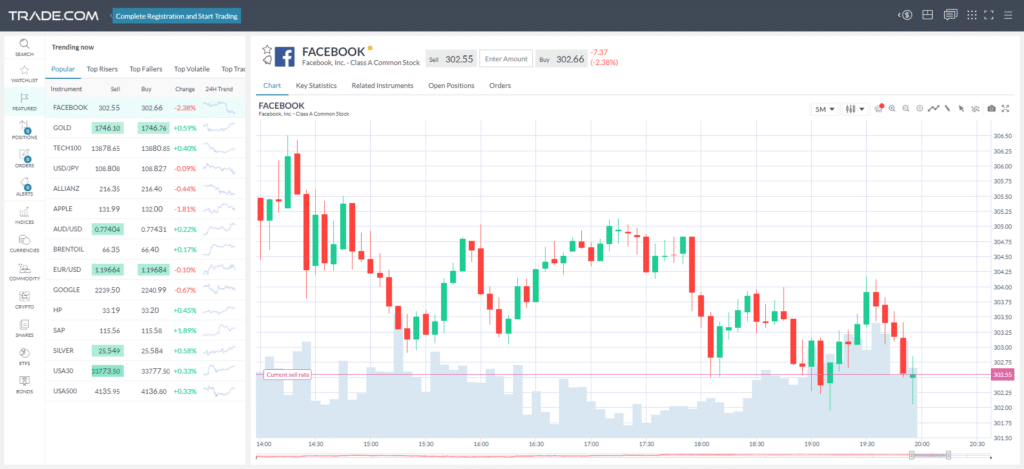
Among the other markets on which it is possible to invest with this broker we also find Forex, cryptocurrencies, bonds, ETFs. For a broker that as a whole has to offer over 2,100 securities on different markets, many of which are almost unobtainable elsewhere.
The choice of platforms is also excellent for Trade.com. The proprietary web platform is flanked by MetaTrader, a trading platform recognized as the best by professional traders. You can access the Trade.com platform from here, with enough capital to test the potential, especially in terms of market operations and spreads.
| Platforms: | Webtrader, Metatrader |
| Type of assets: | Forex, Stocks, ETFs, Commodities, Indices, Crypto, Bonds |
| Tradeable assets: | 2.100+ |
| Main feature: | Metatrader, very tight spreads |
| Official Website: | https://trade.com |
FP Markets is an Australian based broker that now offers its services in Europe as well, by virtue of a license obtained in Cyprus (but also holds the Australian ASIC license). A broker that has made the extreme depth of its CFDs offer on stocks which is one of its main strengths.
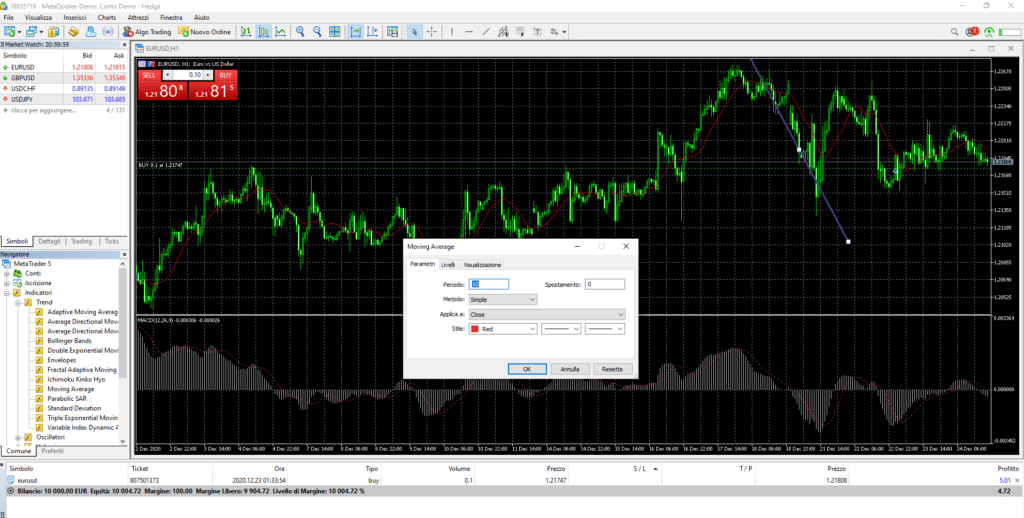
There are in fact over 11,000 stocks, the bulk of which are distributed on the stock markets of the USA, Australia, Hong Kong and London. Under the rest of the markets FP Markets has a lot to offer as well, with a decent depth on Forex as well. Completing the picture is the dual platform MetaTrader plus IRESS Platform, the second of which is intended for those who want to trade via CFDs but in DMA pricing mode and therefore with fixed commissions.
You can test them in the free demo, limited to the MetaTrader version, which is still the basic one for those who want to trade in CFDs.
| Platforms: | Webtrader, Metatrader |
| Type of assets: | Forex, Stocks, ETFs, Commodities, Indices, Crypto, Bonds |
| Tradeable assets: | 11.000+ |
| Main feature: | Possibility to trade small-cap and mid-cap stocks |
| Official Website: | https://fpmarkets.com |
Investing in CFDs: 👍Pros and 👎Cons
Like all financial instruments, CFDs are not perfect. Their use is recommended when you want to make an investment of a speculative nature using leverage, also taking advantage of the possibility of selling short. Let’s see what their pros and cons are, when they can be useful and when they are not.
PROs of CFDs:
- Low limits for investing
CFDs, especially when they are traded on leverage, have the great advantage of being able to offer access even to those who want or can invest little. This allows you to build well-diversified portfolios even with a few hundred euros.
- Neutral access
There are no preferred markets for CFDs. On the contrary, the structure of the contracts and the associated costs and commissions allow us to invest neutrally on all markets that may be of interest to us. This freedom cannot be guaranteed by any other instrument currently available on the markets and accessible even to those who are not millionaire investors.
- Short selling
We consider it to be an even more useful tool than leverage, which remains important when it comes to CFDs. Thanks to short-selling in fact it is possible to ride out negative trends that otherwise, in direct purchase mode, are impossible to exploit. However, there are also some CONs of CFDs, which must be carefully evaluated before choosing this type of instrument for your trading operations:
- Costs
By choosing unsuitable brokers it is possible to incur costs that are much higher than those of classic brokers. Overnight commissions are not always clear, even in this case when one does not use a correct and adequate trader.
- Inexperience
The possible use of tools such as leverage by inexperienced traders can result in significant losses. Of course, this is not the fault of CFDs, which simply provide a tool. The fact remains that those who are not able to control themselves or are thinking of approaching the markets without a precise strategy may be tempted by CFDs to take greater risks than necessary.
Is it worth trading CFDs?
Yes, we believe that CFDs are tools that effectively allow everyone to trade, at a very low cost and with access to markets otherwise beyond the reach of small investors.
It is undeniable that they are instruments of absolute and total democracy on the financial markets, offering the same opportunities both to those who invest significant capital and to those who do not have much to invest.
Of course, this does not mean that they are instruments suitable for everyone, but the fact that they are not hyper-safe instruments and that they shield the saver from any possible loss should not be misleading. Those who choose to invest freely and without the typical protections of managed savings, choose to run more risks but also choose to keep in their pockets the bulk of the commissions they would otherwise have to pay.
Characteristics of CFDs
There are some things that you need to know before you start investing in CFDs. Let’s go through them one by one, while also comparing these characteristics peculiar to CFDs to what is offered by other financial assets.
Expiration of CFDs
CFDs have no expiration date, at least when the underlying asset is not subject to expiration. When we invest therefore in Forex, Stocks, Commodities (not in futures version), Cryptocurrencies and ETFs the contract can absolutely be considered as perpetual.
The situation is different for those CFDs that instead have, as underlyings, securities with an embedded maturity. This is the typical case of futures, as well as bonds that can be traded through CFDs. All the best brokers offer a particularly clear prospect of the eventual expiration of a CFD, thus allowing us to organize our trade taking into account this very precious information.
When a CFD expires, if it is scheduled to expire, the position is rolled over. The broker will automatically credit or debit the difference necessary to replace the just expired contract with an identical one, but with a future expiration.
CFDs: Costs and Commissions
CFDs are subject to two types of commissions that affect the cost of the contract both when buying and selling, and when a trade remains open from one day to the next.
In fact, all CFD brokers operate by applying a spread, which is the differential between the actual market price and the price charged on the platform. We will deal with this specific type of commission in CFD trading in a moment.
Then there are the overnight commissions, which are due for every position held open after the markets close. In this case, an annual interest rate is applied, divided on the day, to which a further (and small) spread is applied by the broker itself. All brokers report, at the moment of the order, a precise quantification of the quantity of overnight commissions that will be charged on the position.
CFD spreads
CFDs do not incur trading costs similar to the fixed costs we typically see when purchasing securities directly through bank brokers. This of course does not mean that CFD brokers offer services completely free of charge. The commissions that are collected by brokers offering CFDs take the form of spreads, that is, the difference between the actual spot price on the market and the one we can find on the platform.
The following example may help to understand the actual scope of this type of commission. If the price of ENI on the stock exchange is 7.04 EUR for the purchase and 7.06 EUR for the sale, the broker tends to offer on his platform more divergent prices, in the form of 7.03 EUR and – always as an example – 7.06 for the sale. The difference between the real price and the price charged by the broker is called spread or differential.
Spreads can be fixed or variable, i.e. they can remain constant over time or be raised and lowered by the broker depending on market phases. Usually, brokers with variable spreads tend to raise them in moments of particular volatility: it is a way for the broker to protect himself and avoid exposing himself directly to easy gains by the client.
CFD assets
CFDs owe part of their popularity to the fact that they can have practically all asset classes available through the financial markets as underlying assets.You can invest via CFDs in:
- Forex
Forex trading is largely done through CFD contracts, which allow not only to apply a maximum leverage of 1:30 on the main pairs, but also to have very convenient tools for short positions. Although technically we are used to considering this type of contracts as separate from CFDs, technically they are, and the same characteristics and commissions are applied to them as we are used to seeing for classic CFDs.
- Stocks
As far as trading in shares is concerned, CFDs have the enormous advantage over DMA purchases of being able to offer the investor neutral access to any type of market. Our reference is obviously to the overseas markets, on which, for clear and understandable reasons, bank brokers practice decidedly important commissions.
With CFDs, access is by the same means, whether you want to trade on a stock listed in Paris, in Hong Kong or in the USA. CFDs on equities have therefore offered many small investors the possibility of linking their investment to markets that were once inaccessible because they were prohibitively expensive and difficult to operate.
- Commodities
Here, too, CFDs have played the role of making life easier for retail traders. Until the arrival of CFDs on the markets, it was practically impossible for small and medium-sized investors to trade on contracts which, dry, required minimum investments starting from lots of 100,000 USD.
CFDs, on the other hand, allow fractional investment even on this type of product, freeing up access for those who want to bet on oil, gold, natural gas but also on soft commodities without having large amounts of capital at their disposal.
- ETFS/ETF
It might seem curious that passively managed funds, which often incorporate leverage, can be CFD underlyings. This actually shouldn’t come as a surprise to anyone who has tried trading CFDs on ETFs. Because we still have access to lower commissions and we can take advantage of leverage other than that which may be embedded in the security. Lastly, thanks to CFDs we can also sell short the value of an ETF.
- Cryptocurrencies
Investing in cryptocurrencies without resorting to CFDs presents major problems that must be taken seriously. Without CFDs, the only plausible alternative is cryptocurrency exchanges, virtual hubs that are often not registered as financial intermediaries and therefore offer far fewer guarantees.
In addition, CFD brokers charge on average much lower commissions, making investing via these contracts more profitable all-round than buying Bitcoin and altcoins directly.
- Bonds
Bonds, a classic investment banking instrument, can also be traded via CFDs. The advantages in this case compared to the classic investment is certainly constituted by the possibility of applying leverage, on products that tend to move very slowly at price. The bonds typically traded by CFD brokers are the American ones, with the possibility of sometimes also finding some European securities.
- Futures
Futures are also products that are sometimes listed by CFD brokers. Futures are derivative contracts themselves, and it may seem counter-intuitive to buy a derivative on another derivative. Here again, the advantage may lie in what are the strongest pieces for CFD traders: lower transaction costs, instant liquidity, and the ability to comfortably act short as well.
- Indices
Almost all brokers that deal in CFDs deal in contracts that replicate the performance of a stock market index, as well as sometimes certain regional indexes or even baskets of assets, such as the VIX/VXX volatility index.
CFD’s, along with ETF’s, remain among the very few tools that a small or medium-sized investor has to trade these benchmarks, again, therefore, offering something practically unique in the investment scenario for independent traders and perhaps not with large amounts of capital to invest.
Trading in CFDs: actual opinions and reviews.
CFDs are instruments that can trigger very different reactions, even among the most experienced investors. We will provide our version and opinions, which have matured over years on the markets (which have also included the use of instruments of this type), also indicating which may be additional sources of interesting and informed opinions.
Are CFDs a scam?
No, CFDs are not by their essence a scam: they are regular contracts, which are traded by plenty of more than legitimate brokers and which are also registered as legitimate traders in Europe, the UK, Australia and South Africa, much of Asia and South America.
Therefore, it is absolutely not possible to automatically associate CFDs with fraudulent schemes. However, as in almost all areas of the investment industry, there is a possibility that malicious parties may exploit the popularity of these specific securities to organize real scams.
Let’s start with the fact that since the 2000s CFDs have grown in popularity and today most investors, no matter how small or untrained, are familiar with them. Unfortunately, there are also brokers that are not registered in Europe – with fanciful offices in the Caribbean or Pacific islands – or even clones of legal brokers that offer (fake) CFD-style trading.
Therefore, if it is true that CFDs do not automatically mean scams, it is equally true that the fact that CFDs are present on a platform – whether real or fake – does not make you safe from possible scams. These are the most typical cases.
- CFDs used in the domain name
Most of the “brokers” with a website that includes the word CFD have, over time, almost always turned out to be scams – not exactly cleverly organized either. You can find fictitious names or names that follow those of regular brokers.Broker che operano al di fuori dei confini europei
There are two types of offshore brokers: those that operate in legally respectable countries and therefore can be considered reliable and those that operate with offices – real or fictitious – in tax and legal havens.
In both cases, it is better to avoid having any kind of relationship with those brokers who are not authorized in Europe. In the second scenario, we are most probably dealing with 100% fraudulent systems.
As with anything that may affect our assets, it is best to be very cautious. Because the world is full of those who exploit the popularity of online trading and CFDs for fraudulent purposes, even if they are organized in criminal groups.
CFD TrustPilot
Trustpilot remains a very important site for those who want to hunt for reviews, most of the time trustworthy reviews, on brokers that offer CFDs and therefore are the main channel for those who want to choose this type of instruments.
- FP Markets: 4,9 on Trustpilot
FP Markets gets one of the highest scores among the financial brokers present on Trustpilot. It is a clear sign of a first-class focus on its customers, whether it is investing in DMA Pricing mode, or in dry CFD mode.
- Capital.com: 4,3 on Trustpilot
The score obtained by broker Capital.com, is also very high, a clear sign of the quality of the services offered by this specific broker. We are therefore in line with what is reported, also in other locations, by those who have actually used this broker.
CFDs Opinion Forum
There are forums where users exchange opinions and advice on CFDs on a daily basis. We recommend two of them, here it is easy to consult quality threads and above all to study in depth some issues that may concern this type of contracts.
- Forex Factory: a forum dedicated to Forex trading through CFDs that boasts a very active community;
- BabyPips.com: a long-standing point of reference for speculative traders, where they discuss brokers, investment strategies and analysis
- MQL Forum: created by MQL, the same company that owns and manages Metatrader, it is arguably the most active community talking about CFD trading.
Learn CFD trading
Trading in CFDs largely follows the same operating rules as investing in the direct purchase of the stock. However, there are certain differences, which arise from the additional tools that contracts for difference offer to those who use them.
Therefore, we have collected courses, insights on strategy and market analysis, video courses and books that can help us learn more about the world of CFD investments.
CFD courses + Free Pdf
We have chosen the best courses that also deal with CFDs, as well as delve into the topics needed for those who want to trade in the financial markets. All the resources mentioned below are free to consume and can be accessed easily on Youtube or other open access platforms.
- Free 1215 Day Trading course (available on Youtube)
1215 is a company that specializes in day trading and CFD education. Unlike many “gurus” present in this niche area, it does not make promises of big gains and in the content the risks of day trading on derivatives are clearly explained.
The free course that the company has made available on YouTube consists of 10 lessons, each covering a different topic. For someone who is just starting to get into CFDs, this is a practical and easy-to-follow resource that covers all the important basics.
- Investmate (free app from Capital.com)
Investmate is a completely free app, available for both iOS and Android. Inside you’ll find lots of little lessons about investing, financial markets and CFDs. The app is organized into topics, each of which is in turn divided into lessons. This organization helps you learn exactly what you’re interested in when you’re interested, making sure you grasp the learning concepts with quizzes from time to time.
The best thing about Investmate is that the authors are renowned and reliable.The creator of the app is Capital.com, a very serious broker operating in Europe and the UK with regular CySec and FCA licenses. This guarantees the accuracy of the information, the experience of the authors and the validity of the content.
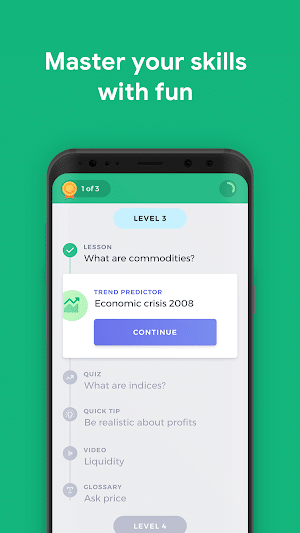
You can choose what you want to learn from 30 different major topics. Each topic is further divided into lessons that can be taken in a few minutes, and then you can take a quiz to check your progress. This is a great tool for people that have little time to learn about CFD trading and want to maximize the amount of information they can learn during that time.
- Official paper of ESMA (available here)
ESMA (European Securities and Markets Authority) is the highest European authority on financial laws and regulations. In February 2013, it published this official paper giving information about CFDs, especially from a legal point of view. The paper uses language that is easy to understand, it uses a very concise structure that presents the concepts with clarity.
Although it is only 5 pages long, it is an interesting read especially for European investors. Undoubtedly, ESMA has a neutral standpoint and is not interested in making you use or avoid CFDS, just like we do. It is always better to avoid learning from sources that have a conflict of interest with what they are teaching about the financial markets.
CFD Analysis
Both technical analysis and fundamental analysis can be used successfully by those who want to trade CFDs. They are two different approaches, these are based respectively on mathematical study and the analysis of the economic environment. Here below, we would like to present both of them.
- Fundamental analysis
Fundamental analysis can be qualitative, when it analyzes non-numerical data that may have an impact on the future value of a security, or quantitative, when it starts with numbers and numerically verifiable data such as balance sheets, P/E ratios or the GDP of a nation.
Analyzing CFDs with fundamental analysis is exactly the same as applying this type of analysis on the underlyings. When we invest in stocks via CFDs, we have to apply the tools of fundamental analysis specific to the stock market. The same applies to commodities, Forex and all other markets. In this case the fact of trading derivatives does not matter. The price analysis – long term in this case – should be done without any particular differences between derivatives and underlyings .
- Technical Analysis
Also as far as technical analysis is concerned, there are no substantial differences between the study of CFDs and the study of underlyings. The important thing is the type of underlying we have chosen, since the CFD faithfully reproduces its price, adding only a very small spread.
Therefore, tools such as trading indicators, chart analysis and all the assistance that a good trading platform can provide in the application of algorithms and automatic analysis are of fundamental importance. Depending on the asset you are trading, you might want to focus more on technical or fundamental analysis. The Forex market is often regarded as one of the best to apply indicators, while stocks are more influenced by fundamentals and news.
CFD trading strategies
It is usually said that CFDs are particularly suitable for short-term strategies since overnight commissions make it inconvenient to keep positions open for long periods. This is not necessarily true, at least in relation to what those who trade with little capital can afford to do.
A long-term position can be just as convenient with CFDs as with brokers who charge a fixed commission between buying and selling the financial product. Typically, there are no trading strategies that should be excluded from the list of those that we can use with CFDs and financial markets of this type.
As far as short-term trading strategies are concerned, CFDs have always been the preferred instrument of those who operate in such contexts. This is because the absence of fixed trading commissions makes it less expensive to open and close many positions during the same trading day.
Compared to trading in direct purchase, moreover, it must be underlined that CFDs allow to intervene also on negative trends, thanks to short selling, which allows you to bet on the fall of the underlying.
Choosing CFDs therefore increases the strategies available to those who want to trade online, not reduces them. For some types of operations – let’s imagine for example a position on shares with a ten-year horizon – it could be more convenient to operate with another type of instrument. But these are evaluations that need to be taken from time to time.
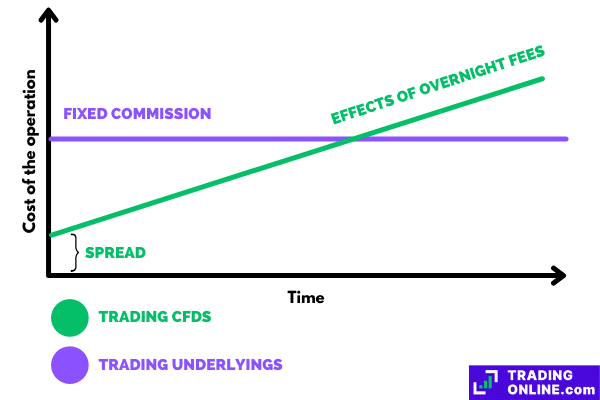
Free video courses on CFDs
We have chosen three different video courses, short but enriched with information, which can help us understand more about what the functionalities and features of CFD trading are.
- CFD Trading Course by TradeCFDs
A very extensive video course, composed of 93 lessons, in which all the theoretical and practical aspects that can be useful for an investor to better understand CFDs and the way they are traded are covered. There are also very interesting parentheses on strategies and different approaches that can be used to improve performance. For a free course published on Youtube, this has a really considerable amount of content.
- CFD Tutorial on Trading 212 by Mitch Investing
A very short and 100% practical video. The author, a day trader already well-known on Youtube, explains exactly how to use CFDs within a trading platform. After you have seen all the theory in our guide, you may want to take a look at the practical way they are traded. The video also mentions the percentage of investors losing money on CFDs, and explains the most common reasons behind their lack of success.
- Avoid CFD Trading by Money Unshackled
Surely many will find it intriguing that we have included a video that is basically against CFDs. Instead, we find it extremely educational, because even with some exaggeration, this video highlights critical points that we believe should be taken into due consideration when trading with these specific instruments. As it is always better to hear different opinions, we think that this can be a valuable video for you after all we have talked about in our guide.
CFD Trading: Best Forums to Learn
We mention here the most active forums that can offer a more concrete foundation for those who want to learn how CFDs work.
- BabyPips.com: a forum entirely dedicated to Forex trading through CFDs, here you can find many interesting strategies to try;
- MoneySavingExperts: dedicated more generally to saving money, but with hundreds of threads dealing on educational aspects including CFD trading. Since most of its users are American, you sometimes hear about brokers who don’t offer CFDs;
- CityWire: a forum created in Great Britain, which surely deserves to be mentioned because it is a gold mine of information and didactic tools for CFDs;
- Reddit: learning on Reddit is possible, also thanks to the constant work of dissemination by active users in the markets. Also here, in the subreddits dedicated to the world of finance, you can find several insights into the world of CFDs. Consider checking r/investing, one of our favourite subreddits about financial markets and how to approach them.
Why invest in CFDs?
There are several reasons why thousands of new investors go down the CFD route every day. On the one hand, it is true that many companies in the industry are active with effective promotional campaigns that attract investors, but it is not just marketing: it is mainly the substance that is appreciated by traders.
It is clear from the simple evidence: millions of investors continue to prefer this approach to the markets over the classic one. There are several undeniable advantages that can answer in detail the question of why to invest in CFDs.
- Neutral access to markets
Neutral access is one of the main values of CFDs, although it is often ignored. Having the possibility to invest in Frankfurt, or on the Nasdaq, or even on the Hong Kong stock exchange under practically the same conditions is a huge advantage over what “traditional” banks and brokers offer.
We can choose any security, based only on the actual convenience it has for our portfolio, without having to limit ourselves to avoid the high commissions that are charged by bank brokers. This is why CFDs are considered a more democratic approach to day trading and investing, as opposed to what we were used to before they became popular.
- Access to distant markets
Furthermore to neutral conditions, it is also the ability to access markets that would tend to be closed to us. It is beneficial to have Chinese stocks available, or even access to agricultural commodities and cryptocurrencies on the same platform.
This is one of the main advantages that has built the great success of CFD trading brokers: millions of Italian and European investors have suddenly found themselves with instruments that can make them invest in markets that were once inaccessible.
- Low investment limits
We are talking first of all about the very small amounts that CFD brokers ask for to open an account; but we are also talking about the possibility to have fractional orders and therefore to invest even a few euros to expose oneself to an action that would be worth, if bought in full, hundreds of euros.
Even the detractors of CFDs must necessarily admit that these securities have meant for many people the possibility to start investing, even without important capital behind them.
The competitive advantage of CFD brokers over traditional ones is also given by the trading platforms. When brokers make use of proprietary and self-developed platforms – as the broker eToro does excellently -, the tools that are offered to the investor are of higher quality than the banking platforms.
When platforms like MetaTrader (unanimously considered the best for online trading even by professionals) are offered, the competitive advantage of CFDs and brokers offering them becomes even more evident.
- Short Selling
For many, short selling is a dangerous tool both in the hands of professionals and, above all, in the hands of those who invest as a hobby or as a side job. In reality, short selling allows everyone to bet on negative trends that, as history teaches us, repetitions occur in the world of finance. We are in favour of personal responsibility and we are especially in favour of providing everyone with the right tools to invest.
It will then be up to the individual trader to decide whether or not to stay updated and well informed, i.e. whether to decide to approach the markets with all possible rationality, or not. Just consider that all evidence-based research points to the fact that short selling is an effective way to price a financial asset correctly.
CFD quotation: how it works
The quotations of CFDs follow, net of the spread, the official quotations of the underlying indicated by the contract. The trend recorded on the Nasdaq, for example on Airbnb shares, is the same as the trend of the CFD on Airbnb.
The only possible deviation is the spread, which is precisely the differential that the broker applies with respect to the official market price. This spread, as should be known at this point of our discussion, is usually extremely reduced, except in cases where markets are particularly volatile, with brokers who give themselves some more freedom.
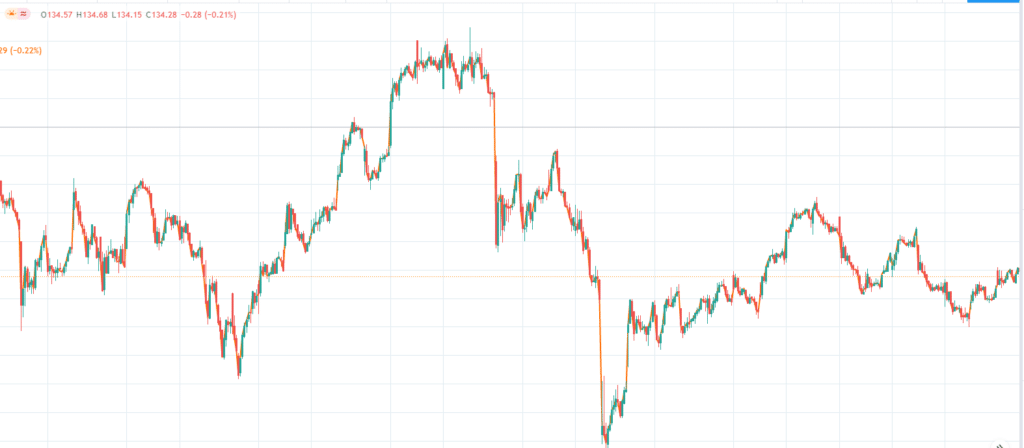
However, by overlapping the official quotations with those provided by any broker, it is possible to see how in reality the quotations are very similar. Differences may occur, in the range of a few pips, when markets are volatile and unstable. Knowing this behaviour of CFDs, you can choose not to trade them in the minutes following an IPO, the results of a general election or when very important macroeconomic data is published.
CFD taxation
Taxation on CFDs depends on the country where the investor resides. Even within the European Union, where many laws are made equal for all member states, the rules differ from country to country. Generally speaking, CFDs are normally taxed on capital gains. This means that when you sell the contract at a higher price than you paid to buy it, thus generating a capital gain, you have to pay taxes on that gain.
However, there are also CFDs that pay dividends, such as those on stocks: in these cases some countries tax them as capital gains, others as dividends. Finally there are countries, such as Cyprus and the UK, where taxation is highly favorable and close to zero. Most legislations allow traders to deduct losses from profits, so that they are only taxed on their net profit from their operations.
Final thoughts on CFDs
CFDs are a subject that often divides: there are those who consider them the solution to every kind of problem for small investors and those who consider them a high and very high risk instrument and to be reserved only for the most experienced.
As is often the case, the truth is in the middle: it is by no means true that CFDs are the ideal tool for everyone, just as it is not true that, with the right knowledge, they cannot also be used to mitigate the risks.
CFDs must be considered as an opportunity offered by the markets today to have more tools for financial trading than we had yesterday. It is largely up to us to decide if and how to operate, what risks to take and ultimately what type of use to make of the contracts for difference.
To make things understandable for everyone, just consider tennis and golf. In tennis, a player uses just one racket the whole game and for the most part of his career as well. In golf, every time the player hits the ball he chooses the most suited club to do so. Investing is like playing golf, not tennis: every time you want to trade, there is an optimal asset to carry your operation. CFDs are one of the tools that you can use, if your country allows it, to manage your investments.
©TradingOnline.com has offered an objective opinion, which allows you to know the true functioning of CFDs, including elements that are often not explained. Are they the right tool for everyone? Certainly not. But it is equally sure that the world of online investments has also been enriched thanks to these tools.
FAQ CFD Trading: Frequently Asked Questions and Answers
What are CFDs?
Contracts For Difference are derivatives that follow the price of the underlying asset and allow fractional investments, short selling and use of financial leverage.
Are CFDs risky?
It depends on the type of underlying. Without leverage they present the same degree of the market risk as the underlying reference. The more leverage you use and the more volatile the underlying asset is, the more risk you take.
Is it legal to invest in CFDs?
It depends on the country you reside in. In the United States it is not legal for brokers to offer CFD trading; in Europe, Australia, South Africa, the United Kingdom, most of Asia and Latin America it is 100% legal. Check the website of the financial authority of your country to know about what laws are in place where you live.
Which brokers offer CFDs?
Among the best ones enabled to operate in Europe, there are eToro, Capital.com, FP Markets and Trade.com. eToro is also available in South Africa, in the UK and in the Seychelles. You can trade using eToro in the USA as well, but in this case you won’t be able to trade CFDs.
What assets can I trade using CFDs?
Forex, Stocks, Commodities, ETFs, Indices, Cryptocurrencies, Futures, Bonds. Some brokers also offer CFDs on options and vanilla options.
What commissions are charged on CFDs?
You pay a small spread between the ask and bid price, as well as an overnight fee for positions held open after 11 p.m.
How much money does it take to start investing in CFDs?
On average, brokers require a 100 €/£/$ deposit to open a live trading account. Depending on the broker itself, minimum deposit can be as high as 10.000$ or as low as 10$.
-

 News4 settimane ago
News4 settimane agoPetrolio, il Brent in mattinata guadagna lo 0,4%. Chiusura settimanale positiva
-

 News4 settimane ago
News4 settimane agoMorgan Stanley rivede i propri obiettivi climatici. La transizione green c’è, ma è lenta
-

 Guide Azioni1 mese ago
Guide Azioni1 mese agoMigliori azioni da comprare
-

 Guide Azioni1 mese ago
Guide Azioni1 mese agoComprare azioni ENI
-
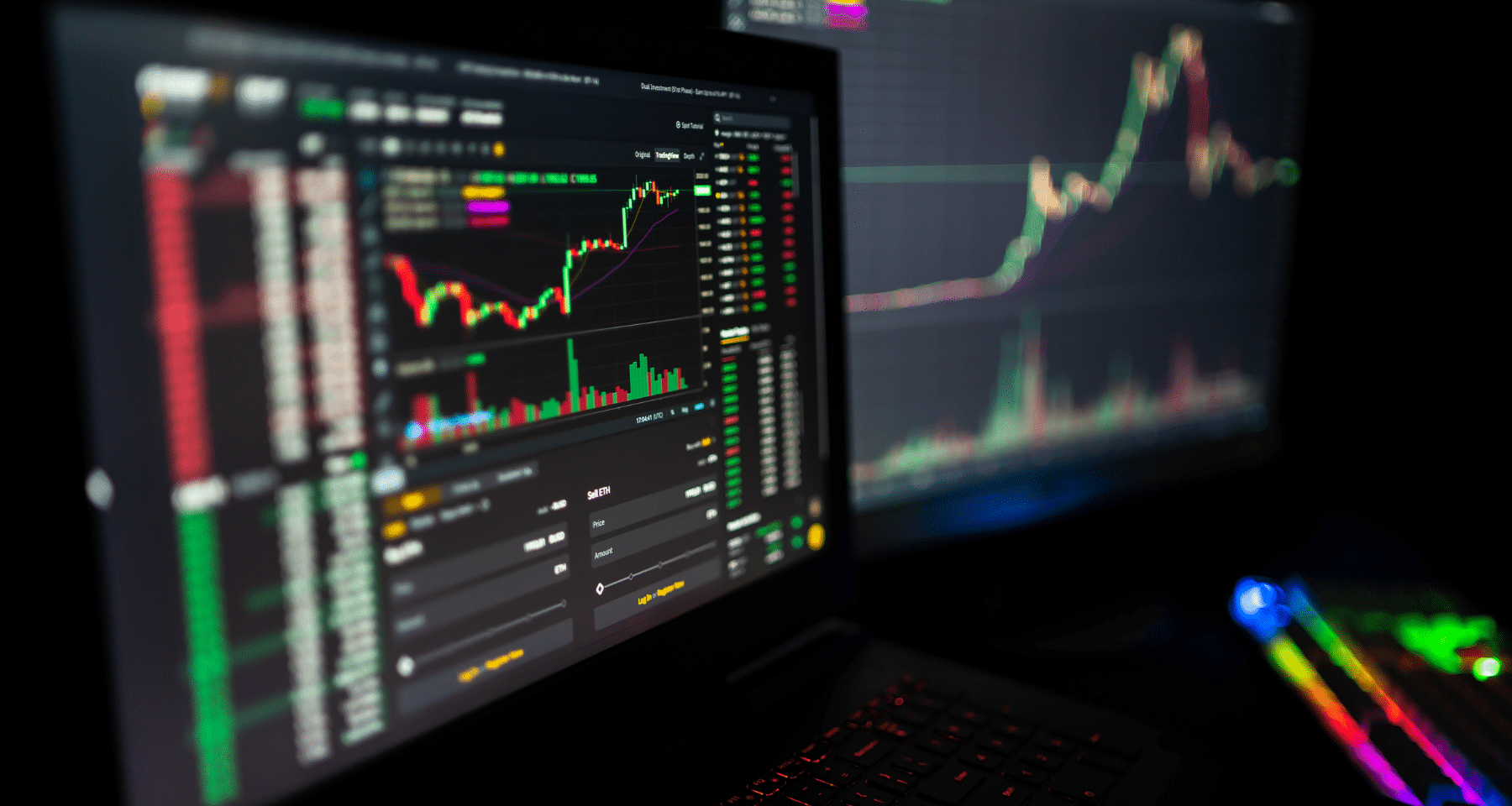
 Guida4 settimane ago
Guida4 settimane agoMigliori 10 Piattaforme Trading Online
-

 Guide Azioni1 mese ago
Guide Azioni1 mese agoComprare azioni ENEL
-

 Guide Azioni1 mese ago
Guide Azioni1 mese agoAzioni intelligenza artificiale














